Special Report
State Economies Most Likely to Be Crippled by COVID-19

Published:
Last Updated:

With more than 1.8 million people infected nationwide and over 100,000 dead, COVID-19 is a public health crisis of proportions not seen in the United States in over a century. The economic fallout in the wake of the virus is equally historic as over the course of only two months, the official unemployment rate spiked from a multi-decade low to its highest level since the Great Depression.
In the face of the pandemic, state and local governments across the country have implemented stay-at-home orders and ordered the closure of nonessential businesses. Here is a look at every state’s rules for staying at home and social distancing.
These efforts, while successful in reducing the spread of the coronavirus, have also had catastrophic economic effects. According to analysis by Moody’s Analytics, an economics research firm, the industries hit hardest by COVID-19 and efforts to contain it include leisure and hospitality, travel services, transportation and warehousing, and oil and gas extraction.
24/7 Wall St. created an index of the pandemic’s ongoing impact on each state’s economy, taking into account the number of COVID-19 cases per 100,000 state residents, the share of employment in industries deemed high risk by Moody’s, cumulative unemployment claims since mid-March, and the official state April unemployment rate.
The official U.S. unemployment rate stands at 14.7%. Across all states, the rate varies considerably, from 7.9% in Connecticut, a state where relatively few workers are employed in industries impacted by the virus, to 28.2% in Nevada, where stay-at-home orders crippled the state’s tourism industry.
While April jobless rates are high nationwide, they will likely only continue to worsen. In May alone, more than 8 million more Americans filed for unemployment. All told, the number of unemployment claims filed since mid-March as a share of the total work force is far higher than the official unemployment rate indicates. Here is a look at every state’s unemployment claims since COVID-19 shut down the economy.
Click here to see the state economies most likely to be crippled by COVID-19.
Click here to see our methodology.
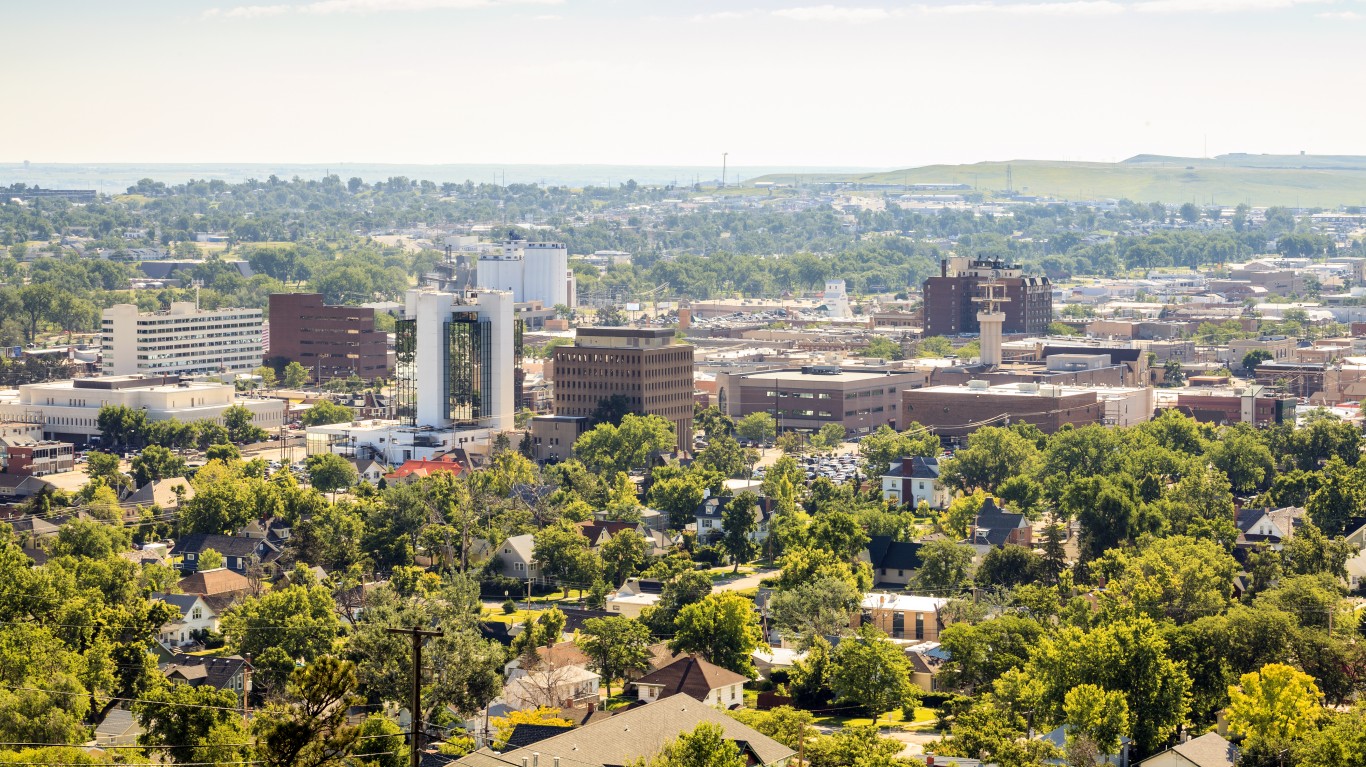
50. South Dakota
> Workforce in high-risk industries: 14.5% of total (2nd lowest)
> Unemployment claims since mid-March: 50,221 (11.0% of workforce — 2nd lowest)
> COVID cases as of June 1, 2020: 5,034 (571 per 100,000 people — 13th highest)
> COVID deaths as of June 1, 2020: 62 (7 per 100,000 people — 13th lowest)
> April unemployment rate: 10.2% (11th lowest)
South Dakota’s economy ranks as the least exposed of any state to slowing down in the wake of the coronavirus pandemic. Only 14.5% of workers in South Dakota are employed in industries that are at high risk of contraction due to efforts to contain the virus, the second smallest share of any state. Since mid-March, only 50,221 workers in the state, or 11.0% of the total labor force, have claimed unemployment — the second smallest share among states.
Perhaps not surprisingly, consumer sentiment remains relatively high in South Dakota. The state’s consumer confidence index stands at 90.4 points — well above the national average of 86.3 points.
[in-text-ad]

49. Utah
> Workforce in high-risk industries: 17.0% of total (25th lowest)
> Unemployment claims since mid-March: 164,539 (10.4% of workforce — the lowest)
> COVID cases as of June 1, 2020: 9,999 (316 per 100,000 people — 23rd lowest)
> COVID deaths as of June 1, 2020: 113 (4 per 100,000 people — 5th lowest)
> April unemployment rate: 9.7% (7th lowest)
Utah is one of the few states that did not issue a statewide stay-at-home order or closure of nonessential businesses, although some municipalities, including Salt Lake County, have issued their own stay-at-home orders. About 165,000 people in the state have filed for unemployment since mid-March, amounting to 10.4% of the labor force — the smallest share of any state.
Infection rates in Utah have also been lower than average. As of June 1, the number of confirmed COVID-19 infections in the state was 316 for every 100,000 people, well below the nationwide rate of 547 per 100,000 people.
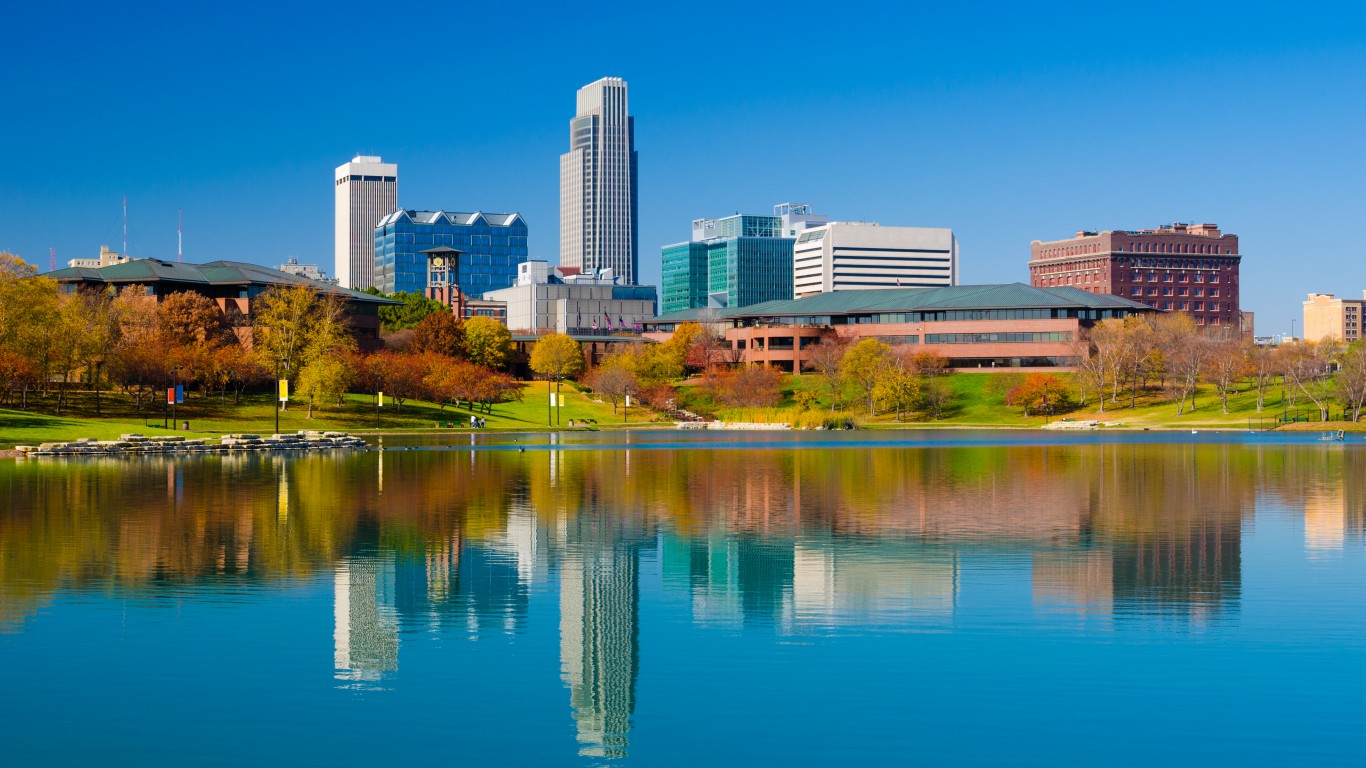
48. Nebraska
> Workforce in high-risk industries: 15.7% of total (11th lowest)
> Unemployment claims since mid-March: 128,821 (12.6% of workforce — 3rd lowest)
> COVID cases as of June 1, 2020: 14,345 (744 per 100,000 people — 10th highest)
> COVID deaths as of June 1, 2020: 178 (9 per 100,000 people — 19th lowest)
> April unemployment rate: 8.3% (3rd lowest)
The structure of Nebraska’s economy has made the state somewhat less vulnerable to the effects of the pandemic and the measures taken to combat it. The state has relatively low employment in particularly hard-hit industries such as leisure and hospitality and mining. Additionally, to date, Nebraska is one the few states not to issue a statewide stay-at-home order or closure of nonessential businesses.
While its economy has not been hit as hard as many other states, infections have been relatively concentrated in Nebraska. There have been 744 confirmed cases for every 100,000 people in Nebraska as of June 1, well above the 547 cases per 100,000 people nationwide.

47. Idaho
> Workforce in high-risk industries: 16.1% of total (16th lowest)
> Unemployment claims since mid-March: 140,807 (16.2% of workforce — 8th lowest)
> COVID cases as of June 1, 2020: 2,839 (162 per 100,000 people — 8th lowest)
> COVID deaths as of June 1, 2020: 82 (5 per 100,000 people — 9th lowest)
> April unemployment rate: 11.5% (18th lowest)
Before the U.S. economy went into freefall, the monthly jobless rate in Idaho was 2.5%, well below the 4.4% national unemployment rate. As of April, the state’s unemployment rate remained relatively low at 11.5% — compared to the 14.7% national rate.
The coronavirus itself has not been especially widespread in the state. Idaho had fewer than 3,000 known cases as of COVID-19 as of June 1. After adjusting for its relatively low population, Idaho has one of the lower number of confirmed cases per capita among states.
[in-text-ad-2]
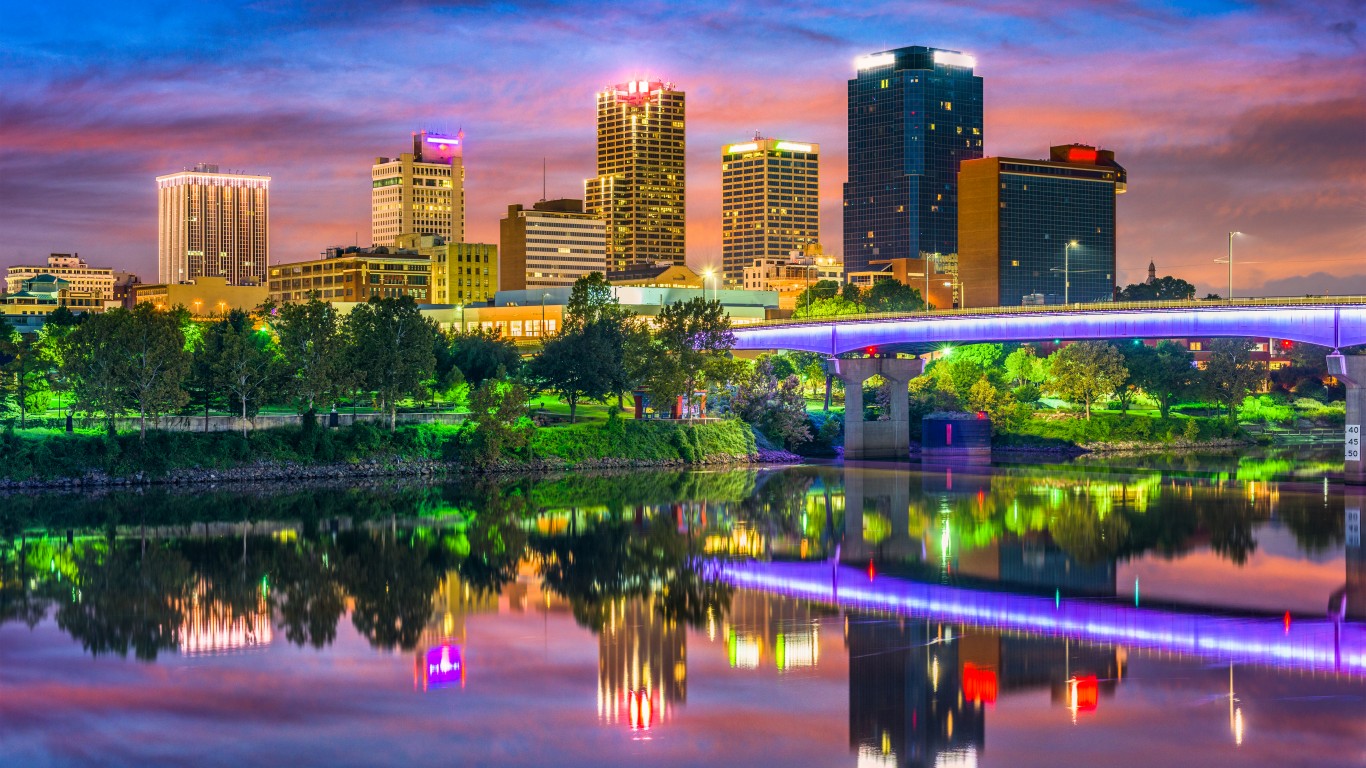
46. Arkansas
> Workforce in high-risk industries: 17.0% of total (23rd lowest)
> Unemployment claims since mid-March: 225,144 (16.6% of workforce — 10th lowest)
> COVID cases as of June 1, 2020: 7,443 (247 per 100,000 people — 15th lowest)
> COVID deaths as of June 1, 2020: 133 (4 per 100,000 people — 8th lowest)
> April unemployment rate: 10.2% (11th lowest)
The April unemployment rate stood at 10.2% in Arkansas — well below the 14.7% national average. The relatively lower jobless rate may explain why state residents are somewhat optimistic about their personal finances and U.S. business conditions as a whole. The consumer confidence index stands at 92.2 in Arkansas, higher than in all but five other states and about 6 points above the national average. Arkansas is one of several states to not impose a statewide stay-at-home order to report more minimal economic fallout relative to most states.
45. Missouri
> Workforce in high-risk industries: 16.6% of total (19th lowest)
> Unemployment claims since mid-March: 585,931 (19.1% of workforce — 19th lowest)
> COVID cases as of June 1, 2020: 13,327 (218 per 100,000 people — 11th lowest)
> COVID deaths as of June 1, 2020: 773 (13 per 100,000 people — 25th lowest)
> April unemployment rate: 9.7% (7th lowest)
Missouri is one of only eight states with an April unemployment rate below 10%. The lower than average unemployment may be due in part to the state’s workforce composition, as a larger than typical share of workers in Missouri are employed in industries that will likely be more resilient to slowdown in the wake of the pandemic.
The virus itself has not been especially widespread in the state. Missouri had fewer than 218 confirmed cases of the virus for every 100,000 people, well below the nationwide rate of 547 cases per 100,000.
[in-text-ad]

44. Maine
> Workforce in high-risk industries: 15.1% of total (8th lowest)
> Unemployment claims since mid-March: 144,075 (21.1% of workforce — 23rd highest)
> COVID cases as of June 1, 2020: 2,349 (176 per 100,000 people — 10th lowest)
> COVID deaths as of June 1, 2020: 89 (7 per 100,000 people — 12th lowest)
> April unemployment rate: 10.6% (13th lowest)
Maine is the only Northeastern state to rank among the 10 states with economies likely to be most resilient in the wake of the pandemic. Workers in Maine are more likely to be employed in industries at low- or moderate-risk of slowdown due to the coronavirus, and partially as a result, unemployment in the state stands at 10.6%. Nationwide, 14.7% of the labor force is out of a job.
Despite the relatively limited economic fallout in Maine, state residents are far more likely than most Americans to be pessimistic about their own finances and the overall health of American business. The consumer confidence index in Maine is the fifth lowest among states.
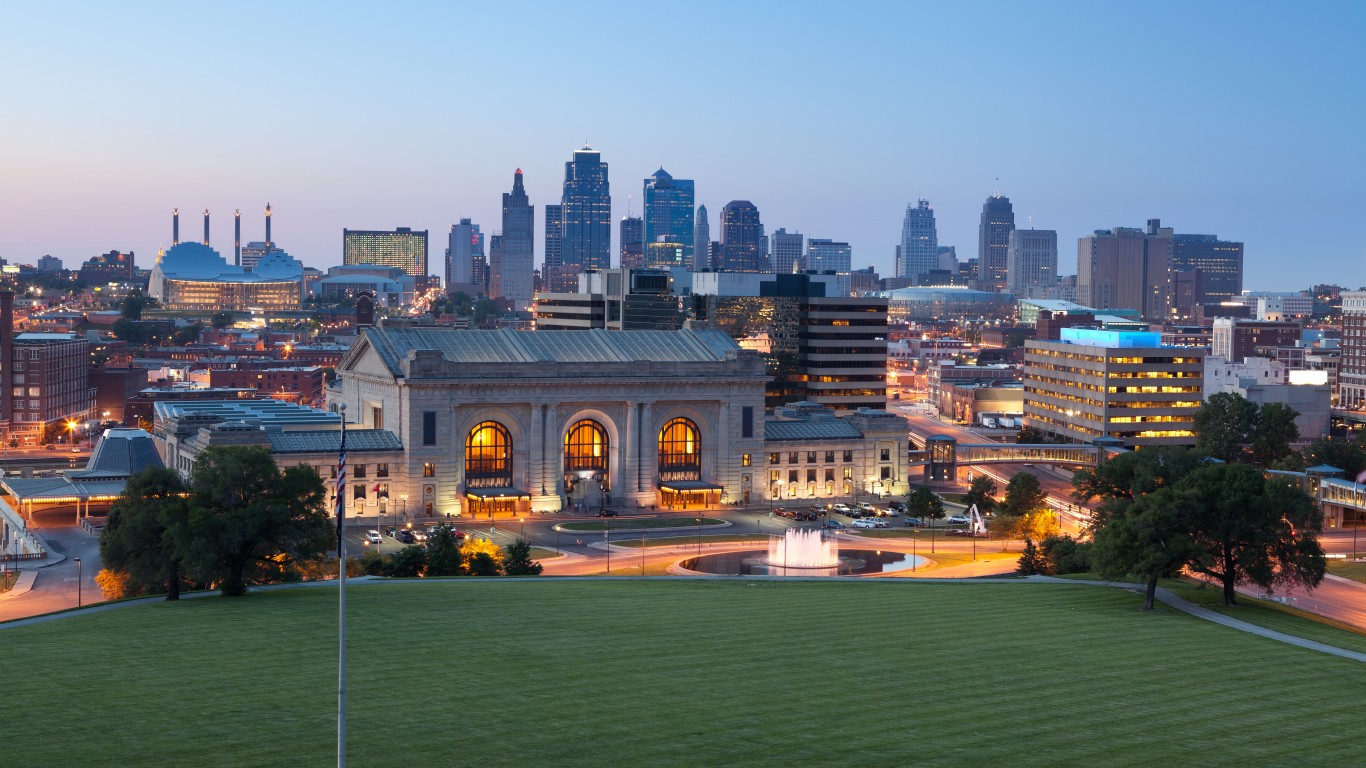
43. Kansas
> Workforce in high-risk industries: 15.8% of total (14th lowest)
> Unemployment claims since mid-March: 264,520 (17.9% of workforce — 16th lowest)
> COVID cases as of June 1, 2020: 9,719 (334 per 100,000 people — 25th lowest)
> COVID deaths as of June 1, 2020: 208 (7 per 100,000 people — 14th lowest)
> April unemployment rate: 11.2% (14th lowest)
Kansas has not reported the same level of COVID-19 diagnoses as much of the rest of the country. As of June 1, there have been 334 confirmed cases per 100,000 people in the state, well below the national concentration of 547 diagnosed cases per 100,000 people.
So far, the virus has also not taken as heavy an economic toll as it did in much of the rest of the country. Unemployment in Kansas stands at 11.2% — well below the 14.7% national unemployment rate.

42. Minnesota
> Workforce in high-risk industries: 14.9% of total (4th lowest)
> Unemployment claims since mid-March: 688,398 (22.3% of workforce — 21st highest)
> COVID cases as of June 1, 2020: 25,208 (449 per 100,000 people — 20th highest)
> COVID deaths as of June 1, 2020: 1,050 (19 per 100,000 people — 17th highest)
> April unemployment rate: 8.1% (2nd lowest)
Only 14.9% of workers in Minnesota are employed in industries that are at high risk of slowdown due to efforts to contain the virus, a smaller share than in all but three other states. Partially as a result, the unemployment crisis is not nearly as bad in Minnesota as it is nearly everywhere else. The state’s 8.1% unemployment rate is second lowest in the country and well below the 14.7% national rate.
Minnesota is also in a better place financially than most states to weather a decline in revenue (because of lower taxes paid and other reasons) in the wake of the virus. The state’s rainy day fund balance accounts for 10.8% of its annual expenditures, a larger share than most states.
[in-text-ad-2]

41. Virginia
> Workforce in high-risk industries: 15.7% of total (13th lowest)
> Unemployment claims since mid-March: 782,697 (17.9% of workforce — 15th lowest)
> COVID cases as of June 1, 2020: 45,398 (533 per 100,000 people — 15th highest)
> COVID deaths as of June 1, 2020: 1,392 (16 per 100,000 people — 21st highest)
> April unemployment rate: 10.6% (13th lowest)
A relatively small share of workers in Virginia are employed in industries that are particularly vulnerable to slowdown in the wake of the measures taken to slow down the spread of the coronavirus.
Due to the relatively low number of infections in the state and relatively favorable employment composition, Virginia’s economy will not likely be hit as hard as many other parts of the country by the coronavirus. Unemployment in the state stands at 10.6%, well below the 14.7% national rate.

40. Iowa
> Workforce in high-risk industries: 14.9% of total (3rd lowest)
> Unemployment claims since mid-March: 325,836 (19.0% of workforce — 18th lowest)
> COVID cases as of June 1, 2020: 19,688 (624 per 100,000 people — 11th highest)
> COVID deaths as of June 1, 2020: 538 (17 per 100,000 people — 20th highest)
> April unemployment rate: 10.2% (11th lowest)
Iowa is one of only five states where fewer than 15% of workers are employed in industries that are at high risk of slowdown due to the COVID-19 pandemic. Not surprisingly, the state’s unemployment crisis is not as severe as it is in much of the rest of the country. Iowa’s unemployment rate of 10.2% is well below the national jobless rate of 14.7%.
While Iowa’s economy has weathered the pandemic better than most states so far, it has been hit harder than most states by the virus itself. There have been 624 confirmed cases of COVID-19 for every 100,000 people in the state as of June 1, more than in the majority of states.
[in-text-ad]

39. Colorado
> Workforce in high-risk industries: 18.6% of total (19th highest)
> Unemployment claims since mid-March: 424,716 (13.6% of workforce — 4th lowest)
> COVID cases as of June 1, 2020: 26,577 (467 per 100,000 people — 18th highest)
> COVID deaths as of June 1, 2020: 1,458 (26 per 100,000 people — 13th highest)
> April unemployment rate: 11.3% (17th lowest)
Colorado’s unemployment claims since the crisis began, while high, have been relatively low compared to most other states. Nearly 425,000 Colorado residents have filed for unemployment since mid-March, or 13.6% of the workforce — the fourth smallest share of any state. The state’s official April unemployment rate of 11.3% is also well below the 14.7% national rate.
While Colorado’s economy is faring better than most other states, residents are more likely to be pessimistic about their own personal finances and the broader business community. The consumer sentiment index is lower in Colorado than in 41 other states.

38. Oregon
> Workforce in high-risk industries: 16.4% of total (18th lowest)
> Unemployment claims since mid-March: 412,431 (19.7% of workforce — 24th lowest)
> COVID cases as of June 1, 2020: 4,302 (103 per 100,000 people — 4th lowest)
> COVID deaths as of June 1, 2020: 154 (4 per 100,000 people — 6th lowest)
> April unemployment rate: 14.2% (22nd highest)
Though Oregon was among the first few states to confirm a case of COVID-19, the state was able to contain the spread better than most states. There have been only 103 diagnosed cases of the virus in Oregon for every 100,000 people, a lower concentration than in all but three other states.
Oregon is also in a better position than most states to continue operations in the face of reduced revenue due to the coronavirus. According to a Moody’s analysis, Oregon is one of only a handful of states not projected to have a budget shortfall in the coming year.

37. Vermont
> Workforce in high-risk industries: 15.4% of total (10th lowest)
> Unemployment claims since mid-March: 66,571 (19.4% of workforce — 22nd lowest)
> COVID cases as of June 1, 2020: 983 (157 per 100,000 people — 6th lowest)
> COVID deaths as of June 1, 2020: 55 (9 per 100,000 people — 18th lowest)
> April unemployment rate: 15.6% (9th highest)
Vermont is one of the few states in the Northeast with an economy that will likely fare better than most of the rest of the country. Only 15.4% of workers in the state are employed in industries most exposed to slowdown in the wake of the pandemic. Vermont is also better positioned to absorb a revenue shortfall in the wake of the pandemic. With $224 million in a rainy day fund, Vermont has enough saved to fund about 13% of its annual expenditures, a larger share than all but seven other states.
[in-text-ad-2]
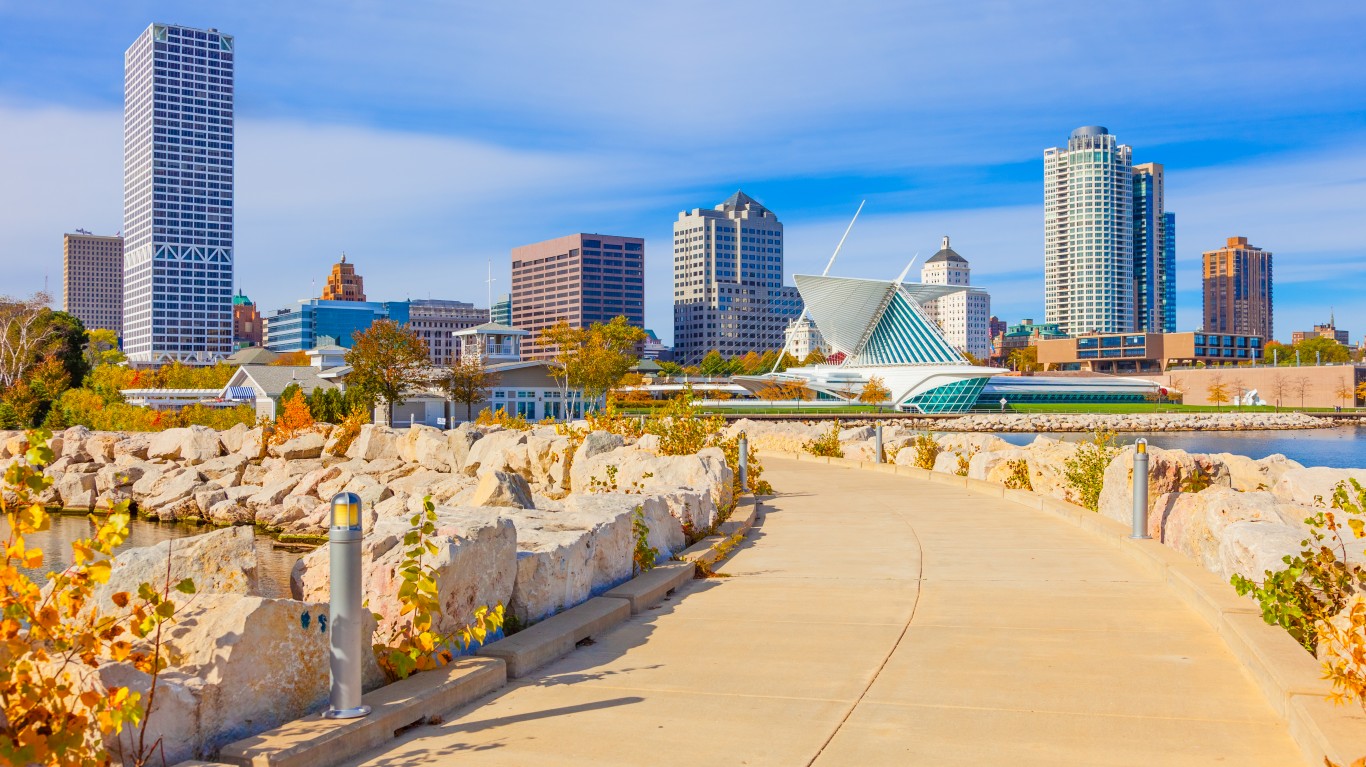
36. Wisconsin
> Workforce in high-risk industries: 15.8% of total (15th lowest)
> Unemployment claims since mid-March: 578,857 (18.7% of workforce — 17th lowest)
> COVID cases as of June 1, 2020: 18,543 (319 per 100,000 people — 24th lowest)
> COVID deaths as of June 1, 2020: 595 (10 per 100,000 people — 22nd lowest)
> April unemployment rate: 14.1% (23rd highest)
Wisconsin has not been hit as hard as most other states by the coronavirus. The state’s infection count of about 319 cases per 100,000 residents is well below the national figure of 547 per 100,000. The economic toll has also been lighter than average in Wisconsin. Since mid-March, just 18.7% of the labor force have filed for unemployment, a smaller share than in the majority of states.
Still, Wisconsin residents are more likely to be pessimistic about their own personal finances and the broader business community. The consumer sentiment index is lower in Wisconsin than in 42 other states.
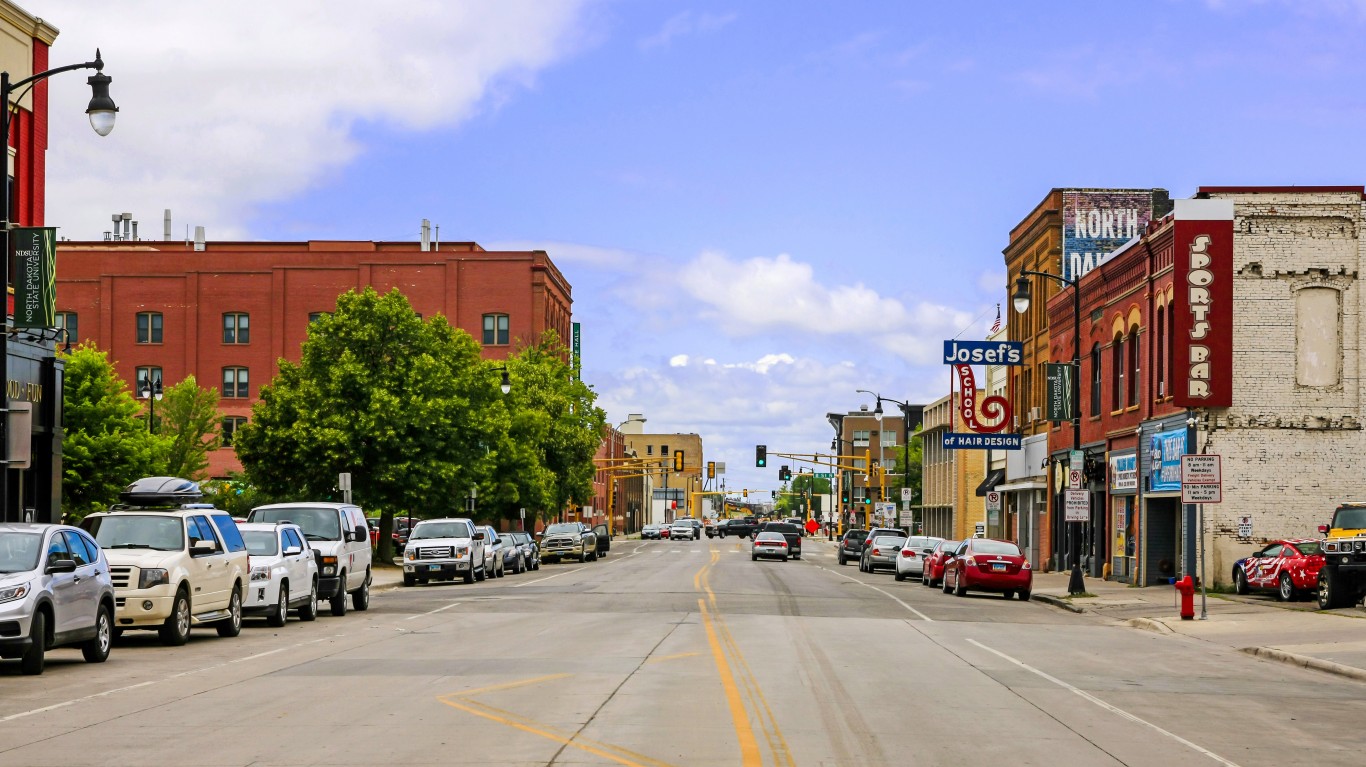
35. North Dakota
> Workforce in high-risk industries: 19.8% of total (8th highest)
> Unemployment claims since mid-March: 70,116 (17.6% of workforce — 14th lowest)
> COVID cases as of June 1, 2020: 2,625 (345 per 100,000 people — 25th highest)
> COVID deaths as of June 1, 2020: 61 (8 per 100,000 people — 15th lowest)
> April unemployment rate: 8.5% (4th lowest)
Despite far higher than average employment concentration in industries at high risk of slowdown as a result of the coronavirus pandemic, such as oil and gas extraction, the unemployment crisis is, so far, not as severe in North Dakota as it is in most of the country. The state’s official unemployment rate of 8.5% is lower than in all but three other states and well below the 14.7% national rate.
North Dakota is also far better positioned to absorb a revenue shortfall in the wake of the pandemic. With $659 million in a rainy day fund, North Dakota has enough saved to fund 34% of its annual expenditures, a larger share than all but two other states.
[in-text-ad]
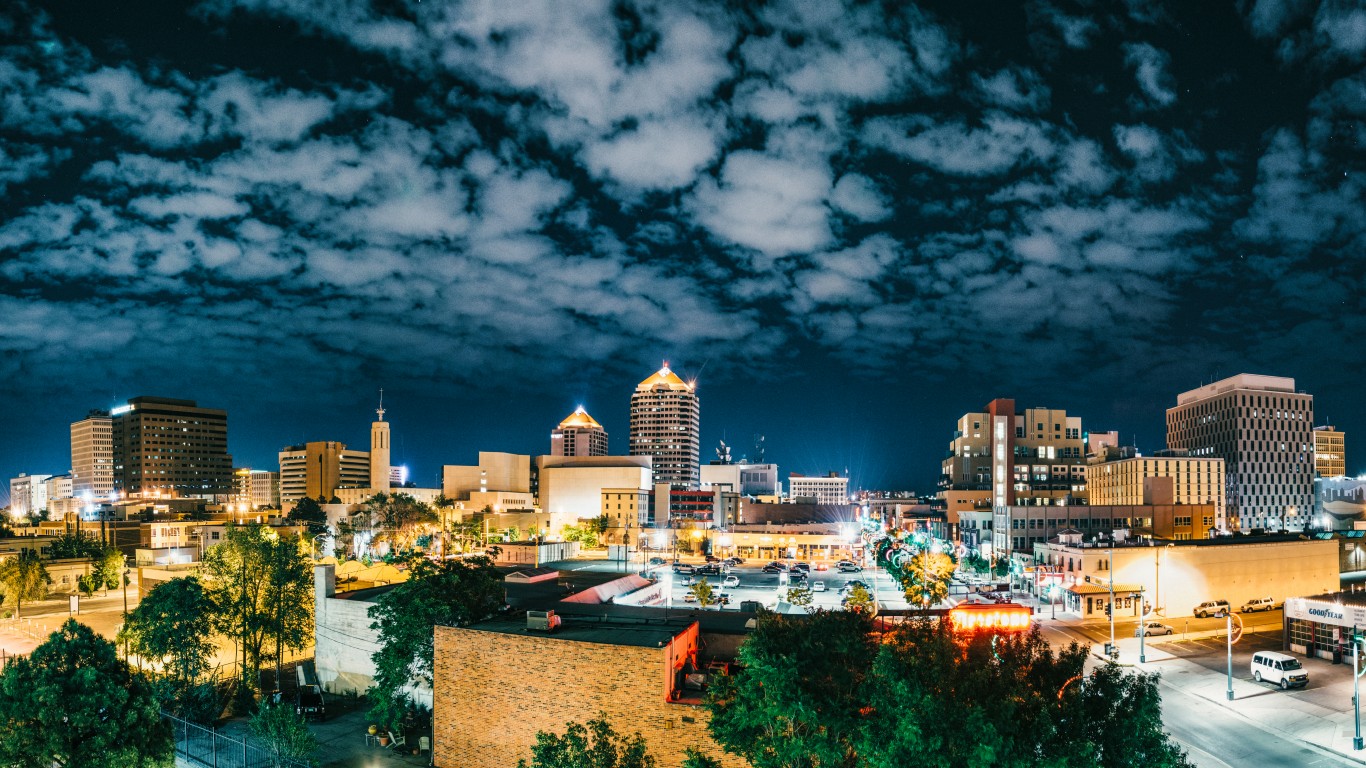
34. New Mexico
> Workforce in high-risk industries: 18.8% of total (18th highest)
> Unemployment claims since mid-March: 152,962 (16.1% of workforce — 7th lowest)
> COVID cases as of June 1, 2020: 7,800 (372 per 100,000 people — 21st highest)
> COVID deaths as of June 1, 2020: 362 (17 per 100,000 people — 19th highest)
> April unemployment rate: 11.3% (17th lowest)
New Mexico’s finances are in better shape than most other states, meaning the state will be better able to function at full-capacity even in the face of revenue declines in the wake of the pandemic. The state has roughly $1.9 billion saved in a rainy day fund, enough to cover nearly a quarter of annual expenditures — a larger share than all but three other states. New Mexico is also one of only a handful of states that is not projected to face a budget shortfall in the coming fiscal year.
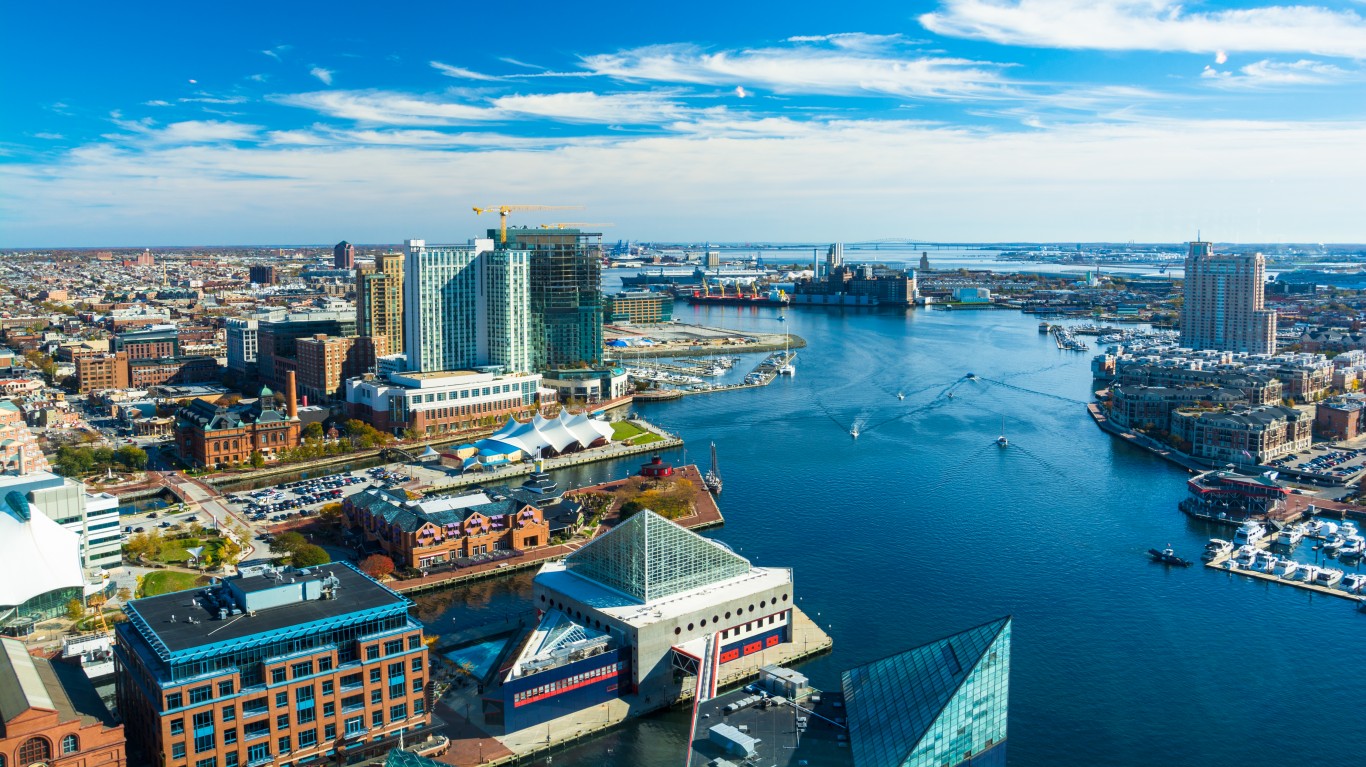
33. Maryland
> Workforce in high-risk industries: 15.7% of total (12th lowest)
> Unemployment claims since mid-March: 562,381 (17.4% of workforce — 13th lowest)
> COVID cases as of June 1, 2020: 53,327 (883 per 100,000 people — 8th highest)
> COVID deaths as of June 1, 2020: 2,552 (42 per 100,000 people — 10th highest)
> April unemployment rate: 9.9% (8th lowest)
A relatively small share of workers in Maryland, 15.7%, are employed in industries that are projected to bear the brunt of the COVID-19 economic fallout. Partially as a result, Maryland is one only eight states where the unemployment rate stands below 10%.
While the unemployment crisis is not as severe in Maryland as it is in most other parts of the country, Maryland has been hit particularly hard by the virus itself. There have been 883 confirmed cases for every 100,000 states residents as of June 1, well above the 547 cases per 100,000 people nationwide.

32. Texas
> Workforce in high-risk industries: 19.6% of total (11th highest)
> Unemployment claims since mid-March: 2,203,183 (15.7% of workforce — 6th lowest)
> COVID cases as of June 1, 2020: 64,880 (226 per 100,000 people — 13th lowest)
> COVID deaths as of June 1, 2020: 1,678 (6 per 100,000 people — 11th lowest)
> April unemployment rate: 12.8% (23rd lowest)
Despite having far higher than average employment in oil and gas extraction — an industry bearing the brunt of the COVID-19 slowdown — Texas has a far lower than average jobless rate. Just 12.8% of the state’s labor force is out of work, compared to the national unemployment rate of 14.7%.
Texas is also in a better position to weather a revenue decline than most states. With a far larger than average 17.4% of annual expenditures saved in a rainy day fund, Texas is one of only a handful of states projected to have no revenue shortfall in the coming fiscal year.
[in-text-ad-2]

31. Montana
> Workforce in high-risk industries: 19.4% of total (14th highest)
> Unemployment claims since mid-March: 104,827 (19.9% of workforce — 25th lowest)
> COVID cases as of June 1, 2020: 519 (49 per 100,000 people — 2nd lowest)
> COVID deaths as of June 1, 2020: 17 (2 per 100,000 people — 3rd lowest)
> April unemployment rate: 11.3% (17th lowest)
Montana to date has had the second lowest COVID-19 infections per capita of any state, at just 49 cases per 100,000 people as of June 1. The state’s job market has also not taken as much of a hit as most other states. Montana’s unemployment rate stands at 11.3%, well below the U.S. unemployment rate of 14.7%.
While joblessness is not as severe in Montana as it is elsewhere, state coffers will likely suffer in the face of a revenue shortfall during the pandemic and ensuing economic slowdown. The state is one of 21 with a projected budget deficit through fiscal 2021 of over 10%.
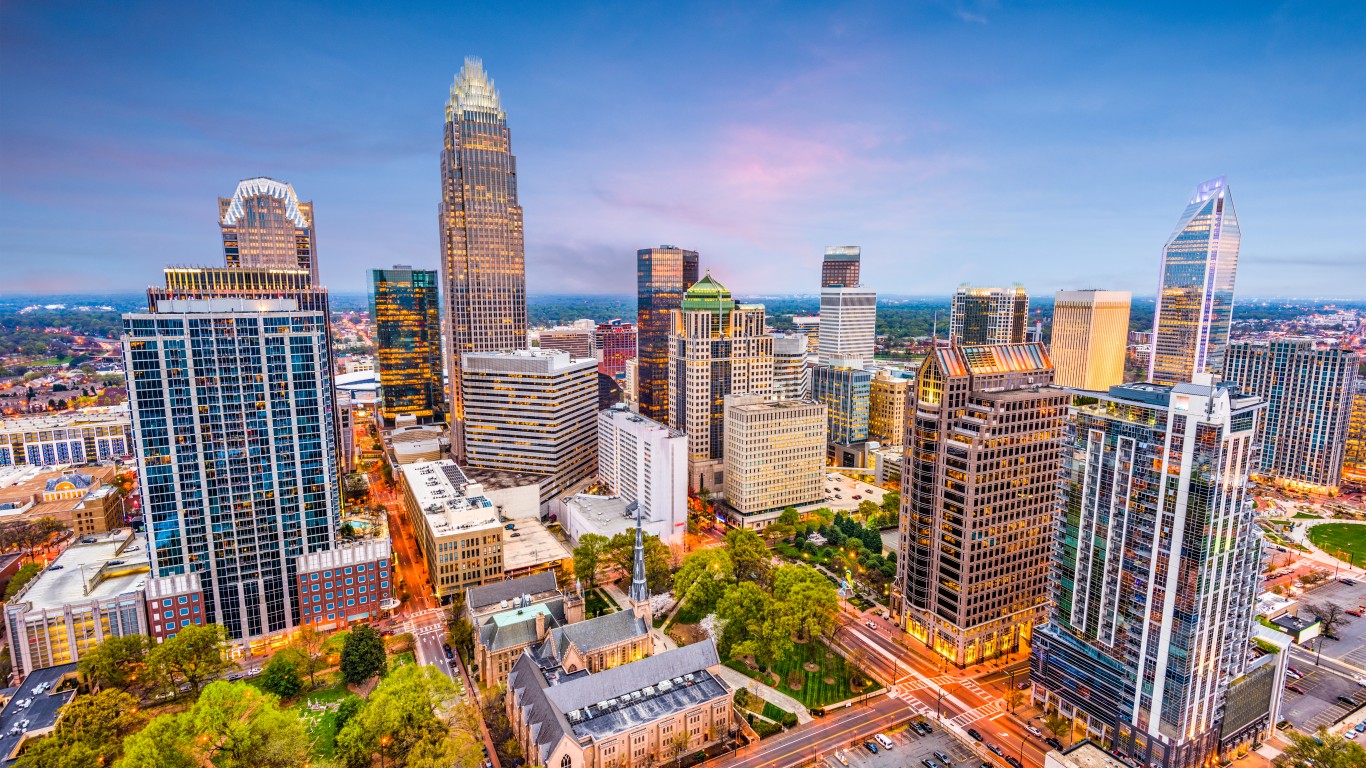
30. North Carolina
> Workforce in high-risk industries: 17.6% of total (23rd highest)
> Unemployment claims since mid-March: 980,705 (19.4% of workforce — 21st lowest)
> COVID cases as of June 1, 2020: 29,263 (282 per 100,000 people — 19th lowest)
> COVID deaths as of June 1, 2020: 898 (9 per 100,000 people — 17th lowest)
> April unemployment rate: 12.2% (21st lowest)
North Carolina ranks towards the middle of all states in most measures of COVID-19-related recession risks. Some 17.6% of the North Carolina workforce is employed in industries identified by Moody’s as high-risk, roughly in line with the 17.7% national figure. Similarly, as of April 2020, North Carolina’s unemployment rate of 12.2% was below the 14.7% national rate.
The state’s biggest weak point may be its underfunded rainy day fund. Nearly every state maintains a revenue stabilization fund to help limit an economic fallout resulting from a recession or another financial crisis. At the end of fiscal 2019, North Carolina’s rainy day fund amounted to just 5.1% of annual expenditure, one of the smallest funding ratios of any state.
[in-text-ad]

29. Connecticut
> Workforce in high-risk industries: 14.2% of total (the lowest)
> Unemployment claims since mid-March: 370,367 (19.6% of workforce — 23rd lowest)
> COVID cases as of June 1, 2020: 42,743 (1,196 per 100,000 people — 5th highest)
> COVID deaths as of June 1, 2020: 3,970 (111 per 100,000 people — 3rd highest)
> April unemployment rate: 7.9% (the lowest)
In Connecticut, just 14.2% of workers are employed in industries identified by Moody’s as high-risk because of the coronavirus pandemic, the smallest share of any state. Likely partially as a result, just 7.9% of the state’s labor force was unemployed as of April 2020, the lowest unemployment rate nationwide and nearly half the national unemployment rate of 14.7%.
While Connecticut is relatively well poised to weather the immediate economic effects of a coronavirus-driven recession, the magnitude and spread of COVID-19 in the state may dampen economic activity in the long run. As of June 1, there were 1,196 confirmed COVID-19 cases per 100,000 state residents, the fifth highest infection rate of any state. According to a survey by market research firm Morning Consult, consumer confidence is currently worse in Connecticut than in all but three other states.

28. Arizona
> Workforce in high-risk industries: 19.3% of total (15th highest)
> Unemployment claims since mid-March: 607,099 (17.3% of workforce — 12th lowest)
> COVID cases as of June 1, 2020: 20,123 (281 per 100,000 people — 18th lowest)
> COVID deaths as of June 1, 2020: 917 (13 per 100,000 people — 24th highest)
> April unemployment rate: 12.6% (22nd lowest)
An estimated 19.3% of workers in Arizona are employed in industries identified by Moody’s as high-risk due to the coronavirus pandemic — such as leisure and hospitality, employment services, and mining — slightly more than the 17.7% national figure.
While Arizona’s industry composition puts it at a somewhat higher risk of a COVID-19-driven recession relative to other states, the state fares well in a number of other measures of exposure. The state’s unemployment rate stands at 12.6%, less than the national figure of 14.7%. Similarly, initial unemployment claims since March 15, 2020 constitute 17.3% of the Arizona labor force, a smaller percentage than in 38 other states.
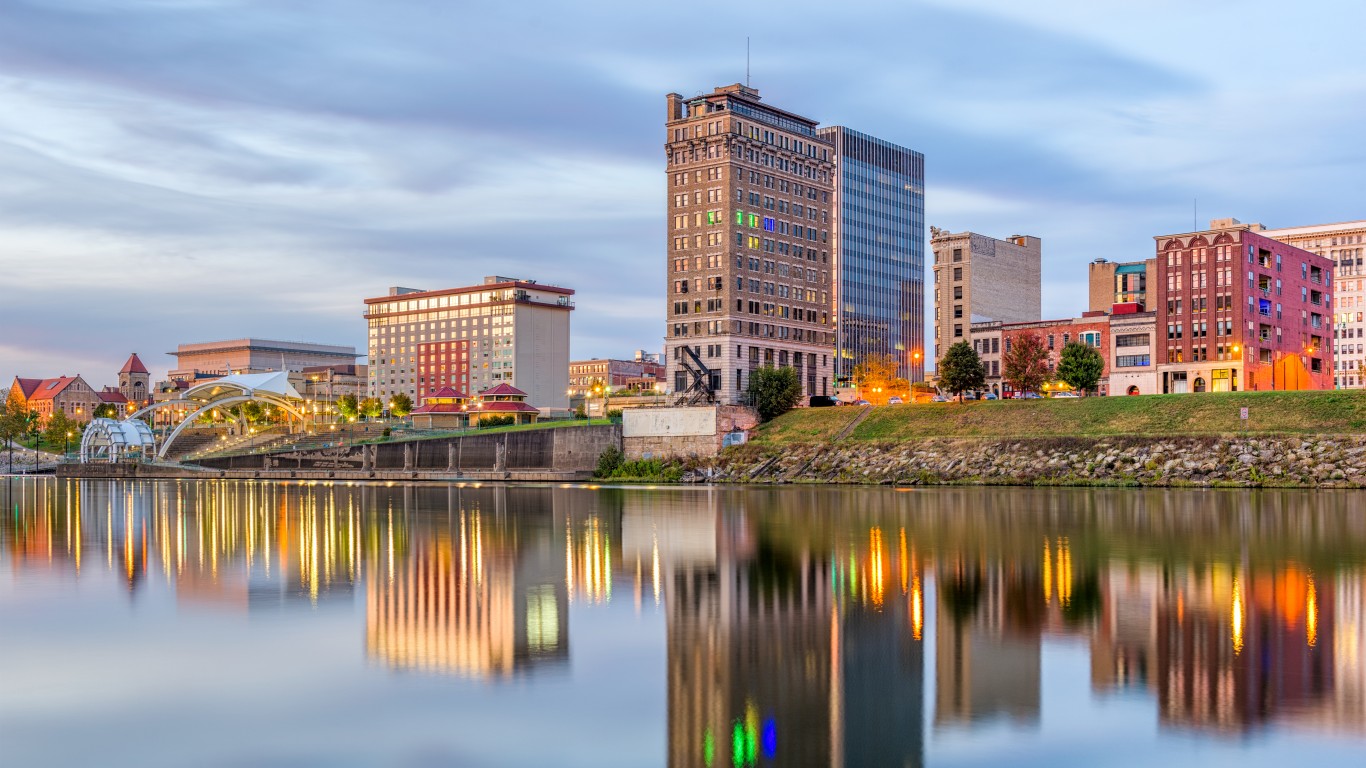
27. West Virginia
> Workforce in high-risk industries: 18.2% of total (20th highest)
> Unemployment claims since mid-March: 152,626 (19.3% of workforce — 20th lowest)
> COVID cases as of June 1, 2020: 1,970 (109 per 100,000 people — 5th lowest)
> COVID deaths as of June 1, 2020: 76 (4 per 100,000 people — 7th lowest)
> April unemployment rate: 15.2% (15th highest)
In West Virginia, 3.1% of the workforce is employed in the mining, oil and gas sector, the fifth largest share of any state. Oil was one of the first sectors to be negatively impacted by reduced consumer demand during the coronavirus pandemic and will continue to suffer during the economic downturn. In total, 18.2% of workers in West Virginia are employed in high-risk industries, slightly more than the 17.7% national figure.
Moody’s projects that the economic slowdown in West Virginia will result in a 30.2% decline in state revenue through fiscal 2021. And while the state’s well-funded rainy day fund — the sixth largest nationwide relative to annual expenditure — will act as a cushion, Moody’s projects the state will ultimately need to cut its budget by some 14.4% in 2021 in order to balance the budget.
[in-text-ad-2]
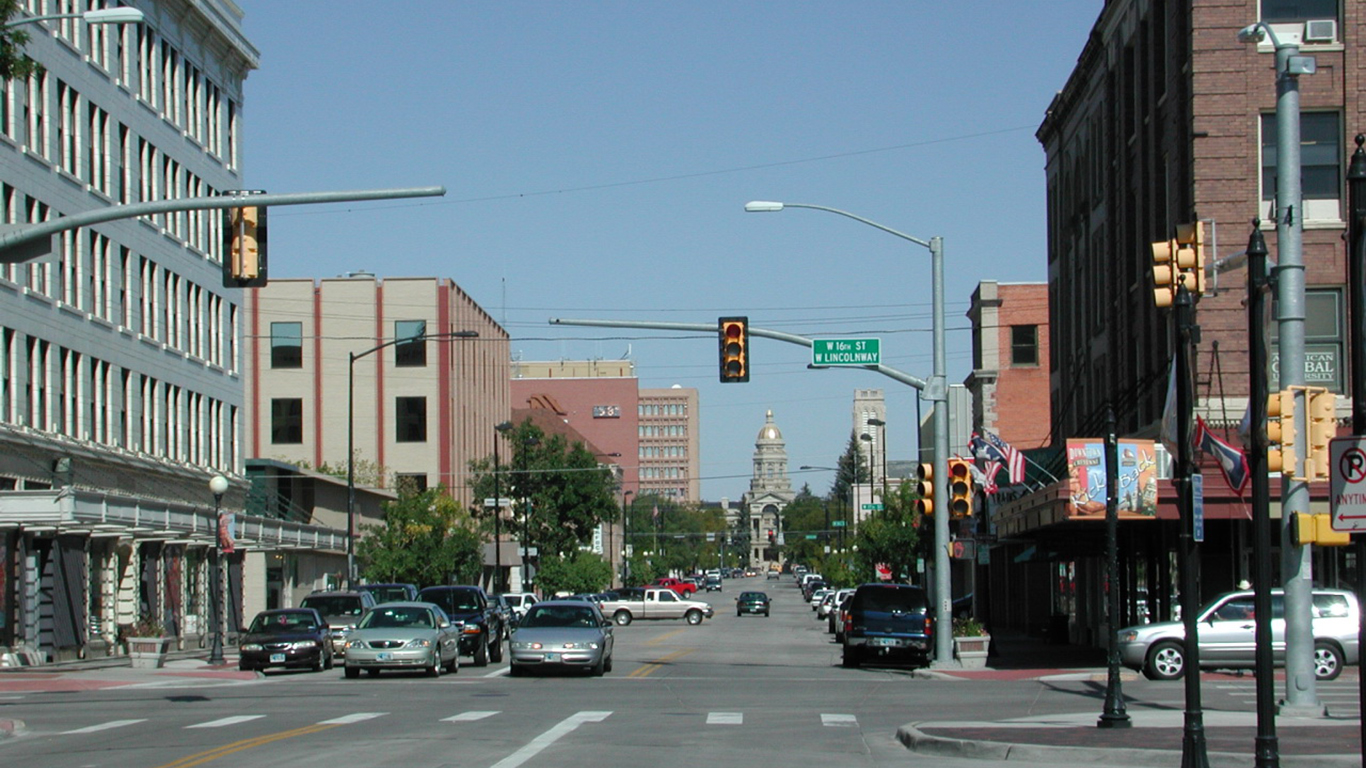
26. Wyoming
> Workforce in high-risk industries: 25.5% of total (3rd highest)
> Unemployment claims since mid-March: 39,956 (13.9% of workforce — 5th lowest)
> COVID cases as of June 1, 2020: 910 (158 per 100,000 people — 7th lowest)
> COVID deaths as of June 1, 2020: 17 (3 per 100,000 people — 4th lowest)
> April unemployment rate: 9.2% (5th lowest)
While Wyoming has one of the lowest COVID-19 infection rates nationwide, the state’s dependence on oil makes it particularly vulnerable to the effects of a global economic slowdown. Some 7.6% of workers are employed in the mining, oil and gas sector, the largest share nationwide. In total, 25.5% of the workforce is employed in industries classified as high-risk due to the coronavirus pandemic, the third largest share of any state.
While Moody’s predicts a majority of states will have to implement budget cuts in fiscal 2021 as a result of the pandemic, Wyoming’s well-funded rainy day fund will likely cushion it from any serious fiscal shock. At the end of 2019, Wyoming’s rainy day fund was equivalent to 138.3% of annual expenditure, the highest funded ratio of any state.

25. Alabama
> Workforce in high-risk industries: 16.8% of total (21st lowest)
> Unemployment claims since mid-March: 52,4617 (23.4% of workforce — 17th highest)
> COVID cases as of June 1, 2020: 18,150 (371 per 100,000 people — 22nd highest)
> COVID deaths as of June 1, 2020: 644 (13 per 100,000 people — 23rd highest)
> April unemployment rate: 12.9% (25th highest)
Alabama ranks towards the middle of all states in a majority of measures related to recession risk. Some 16.8% of workers are employed in industries identified by Moody’s as high-risk, roughly in line with the 17.7% national figure. As of June 1, there were 371 COVID-19 cases per 100,000 people, the 22nd highest infection rate of any state.
One factor that may help Alabama weather the global economic slowdown is high consumer confidence. Alabama was one of the last states to issue a stay-at-home order, and it has since relaxed a number of coronavirus-related restrictions on businesses and individuals. According to a survey by market research firm Morning Consult, consumer confidence is currently higher in Alabama than in any other state.
[in-text-ad]

24. Tennessee
> Workforce in high-risk industries: 20.3% of total (5th highest)
> Unemployment claims since mid-March: 545,154 (16.4% of workforce — 9th lowest)
> COVID cases as of June 1, 2020: 23,554 (348 per 100,000 people — 23rd highest)
> COVID deaths as of June 1, 2020: 367 (5 per 100,000 people — 10th lowest)
> April unemployment rate: 14.7% (18th highest)
According to analysis by Moody’s, industries like leisure and hospitality, transportation and warehousing, and employment services are among the most likely to suffer as a result of the coronavirus pandemic. In Tennessee, 20.3% of workers are employed in such high-risk industries, the fifth largest share of any state.
In other measures of exposure, however, Tennessee fares relatively well. There were 348 COVID-19 cases per 100,000 residents as of June 1, less than the national infection rate of 547 cases per 100,000. Unemployment claims filed since March 15, 2020, amount to 16.4% of the Tennessee workforce, the ninth smallest share of any state.

23. South Carolina
> Workforce in high-risk industries: 19.6% of total (10th highest)
> Unemployment claims since mid-March: 549,288 (23.3% of workforce — 18th highest)
> COVID cases as of June 1, 2020: 12,148 (239 per 100,000 people — 14th lowest)
> COVID deaths as of June 1, 2020: 500 (10 per 100,000 people — 21st lowest)
> April unemployment rate: 12.1% (20th lowest)
Nearly 20% of workers in South Carolina are employed in industries at high risk of a slowdown in the wake of the pandemic, a larger share than the comparable national figure of 17.7%. The higher share of workers exposed to the economic slowdown has contributed to a higher share of unemployment claims. Since mid-March, about 23% of the state’s labor force have filed for unemployment, a larger share than in most other states.
State government finances will also likely be hit harder than average in South Carolina. According to Moody’s analysis, in the event of a moderate recession, revenue will decline by nearly 20% in the state — a larger decline than in most other states.

22. Ohio
> Workforce in high-risk industries: 17.0% of total (24th lowest)
> Unemployment claims since mid-March: 1,261,472 (21.9% of workforce — 22nd highest)
> COVID cases as of June 1, 2020: 35,984 (308 per 100,000 people — 22nd lowest)
> COVID deaths as of June 1, 2020: 2,206 (19 per 100,000 people — 16th highest)
> April unemployment rate: 16.8% (6th highest)
Ohio ranks towards the middle of all states in a number of measures indicating recession risk. Some 17.0% of workers are employed in industries classified as high-risk, in line with the 17.7% national share. As of June 1, there were 308 confirmed COVID-19 cases in Ohio per 100,000 residents, less than the national infection rate of 547 cases per 100,000 Americans.
One factor putting Ohio at risk of a long-term recession is the high unemployment. Ohio had relatively high unemployment before the coronavirus pandemic and has reported a dramatic increase in unemployment over the past few months. The state reported an April unemployment rate of 16.8% — the sixth highest unemployment rate nationwide and up 12.7 percentage points from April 2019.
[in-text-ad-2]

21. New Hampshire
> Workforce in high-risk industries: 15.1% of total (9th lowest)
> Unemployment claims since mid-March: 197,601 (25.7% of workforce — 12th highest)
> COVID cases as of June 1, 2020: 4,685 (345 per 100,000 people — 24th highest)
> COVID deaths as of June 1, 2020: 245 (18 per 100,000 people — 18th highest)
> April unemployment rate: 16.3% (8th highest)
Few states are facing an unemployment crisis as severe as New Hampshire’s. The state’s unemployment rate stands at 16.3% — higher than in all but seven other states and the 14.7% national unemployment rate. That figure will likely only keep climbing as since mid-March, nearly 200,000 New Hampshire residents have filed for unemployment, or over one-quarter of the state’s total workforce.
While New Hampshire’s job market is suffering more than that of most other states, New Hampshire has not been hit particularly hard by the virus itself — especially compared to other Northeastern states. There have been just 345 known cases of the virus per 100,000 people, below the national average of 547 per 100,000 and well below the number of infections in nearby Connecticut, Massachusetts, New York, and Rhode Island.
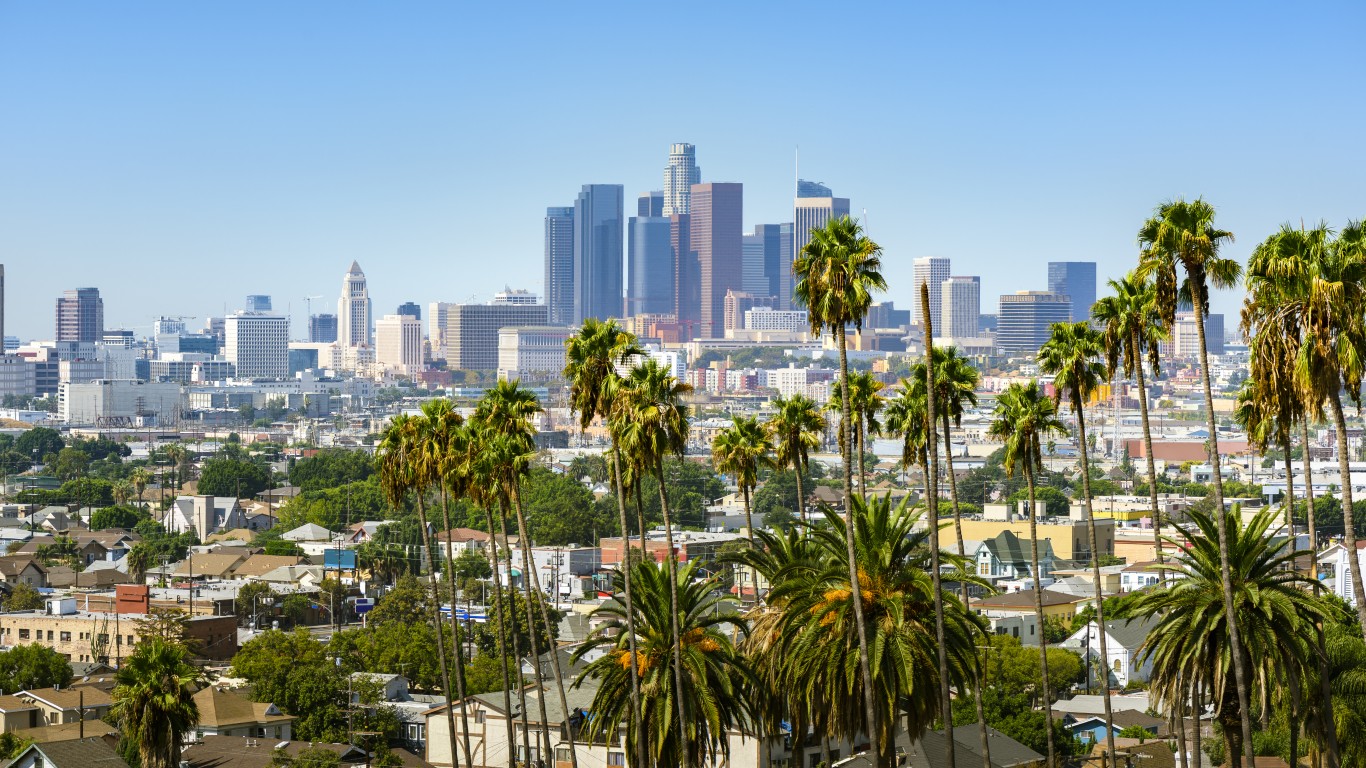
20. California
> Workforce in high-risk industries: 17.9% of total (22nd highest)
> Unemployment claims since mid-March: 4,663,553 (24.0% of workforce — 15th highest)
> COVID cases as of June 1, 2020: 113,006 (286 per 100,000 people — 20th lowest)
> COVID deaths as of June 1, 2020: 4,251 (11 per 100,000 people — 23rd lowest)
> April unemployment rate: 15.5% (10th highest)
California was the first state to implement a stay-at-home order, and currently it has some of the strictest coronavirus-related restrictions in the country. While early government actions may have helped stem the spread of the virus — there were 286 confirmed COVID-19 cases per 100,000 as of June 1, less than half the national cases per capita — high unemployment may put the state at risk of a long-term recession.
As of April 2020, 15.5% of the California labor force was unemployed. Some 4.7 million Californians have applied for unemployment since March 15, amounting to 24.0% of the total labor force — the 15th largest share of any state.
[in-text-ad]
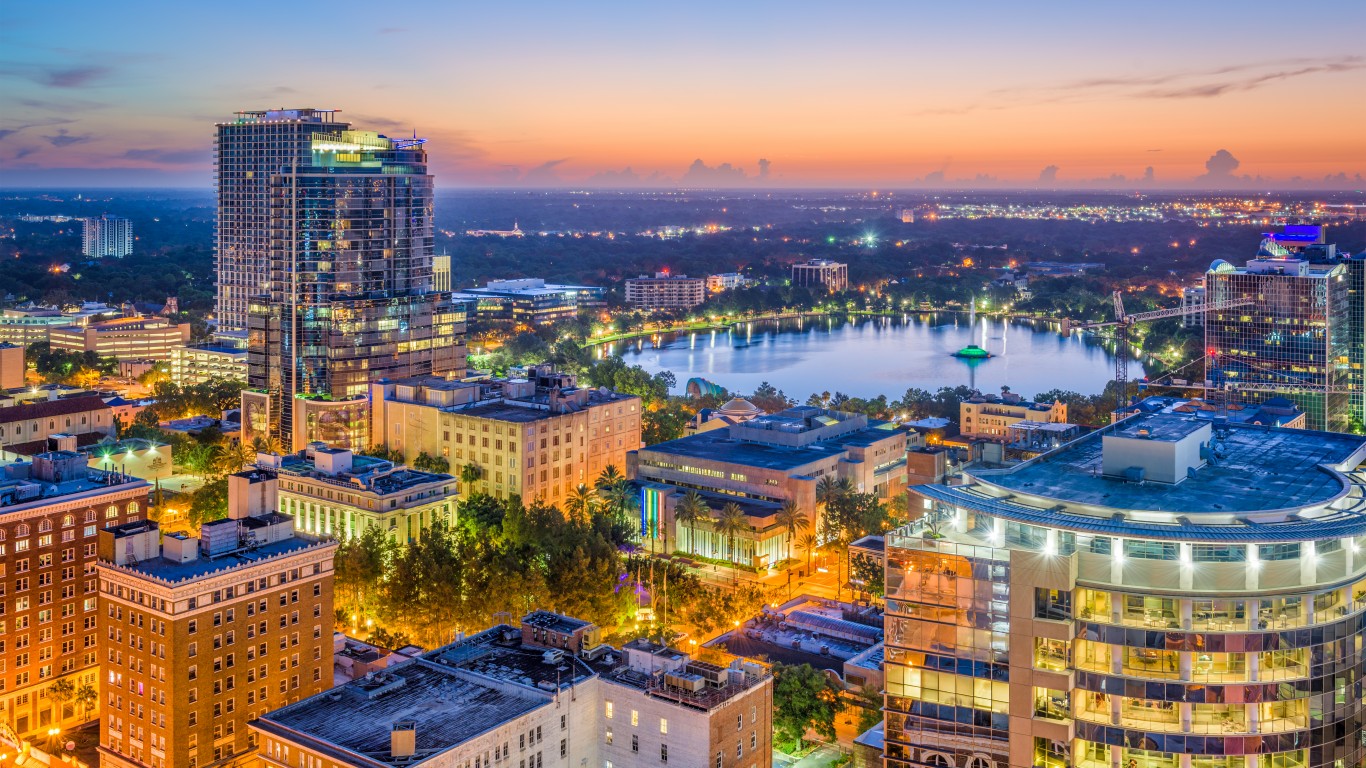
19. Florida
> Workforce in high-risk industries: 20.1% of total (6th highest)
> Unemployment claims since mid-March: 2,388,418 (23.2% of workforce — 19th highest)
> COVID cases as of June 1, 2020: 56,830 (267 per 100,000 people — 17th lowest)
> COVID deaths as of June 1, 2020: 2,460 (12 per 100,000 people — 24th lowest)
> April unemployment rate: 12.9% (25th highest)
In Florida, 14.1% of the workforce is employed in leisure and hospitality — the fourth largest share of any state. The hospitality industry has been suffering because of the pandemic as travel and overall consumer demand have fallen to historic lows. In total, 20.1% of workers in Florida are employed in such high-risk industries, the sixth largest share nationwide.
While unemployment and COVID-19 infection rates in Florida rank toward the middle of all states, Moody’s is projecting a 23.9% drop in state revenue through fiscal 2021. With a small rainy day fund — equivalent to just 4.4% of annual expenditure — Florida might not be able to cover as much as 19.5% of its budget, the fifth largest projected shortfall of any state.

18. Indiana
> Workforce in high-risk industries: 18.0% of total (21st highest)
> Unemployment claims since mid-March: 698,623 (20.6% of workforce — 25th highest)
> COVID cases as of June 1, 2020: 34,830 (520 per 100,000 people — 17th highest)
> COVID deaths as of June 1, 2020: 1,976 (30 per 100,000 people — 12th highest)
> April unemployment rate: 16.9% (5th highest)
While some 18.0% of the Indiana workforce is employed in high-risk industries — nearly in line with the 17.7% national rate — recent reports show that unemployment has risen more in Indiana in the last few months than in nearly every other state. As of April 2020, 16.9% of the Indiana workforce was unemployed, the fifth highest unemployment rate of any state and nearly five times the April 2019 unemployment rate.
Moody’s projects that Indiana will suffer a 19.1% decline in revenue through 2021. While the state’s rainy day fund will cushion some of the fiscal shock, Indiana is projected to have a budget shortfall of 10.5% in 2021, a larger shortfall than a majority of states.
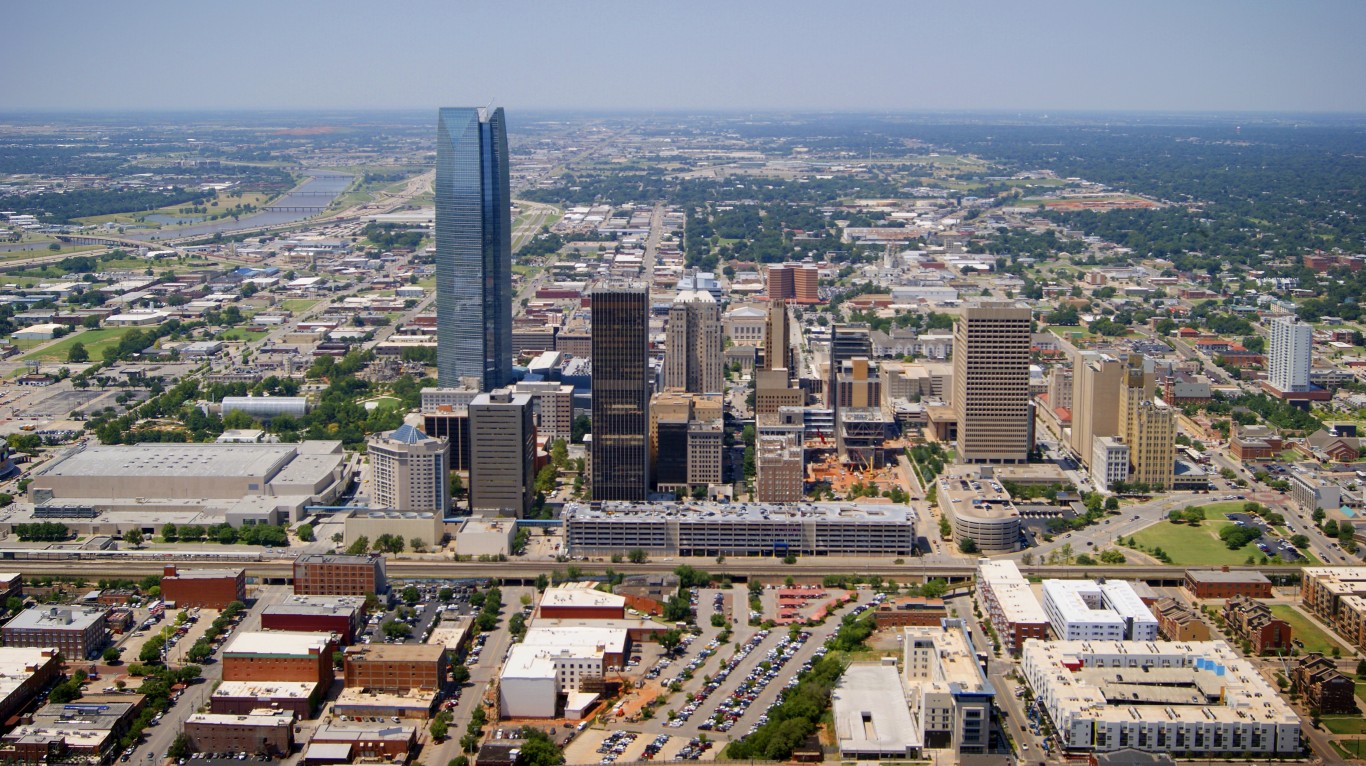
17. Oklahoma
> Workforce in high-risk industries: 19.9% of total (7th highest)
> Unemployment claims since mid-March: 476,013 (26.0% of workforce — 11th highest)
> COVID cases as of June 1, 2020: 6,573 (167 per 100,000 people — 9th lowest)
> COVID deaths as of June 1, 2020: 334 (8 per 100,000 people — 16th lowest)
> April unemployment rate: 13.7% (24th highest)
Prior to the pandemic, almost 20% of Oklahoma’s workforce was in a high-risk industry, one of the higher shares of any state. Notably, the state’s substantial oil sector remains at risk after the plunge of West Texas crude into negative territory in mid-April and as a number of oil and gas operations around the country have announced they could be facing bankruptcy. While oil prices have rebounded somewhat, the long-term economic health of the industry — and the state economy as a whole — remains in doubt. Since mid-March, total unemployment filings in the state have totaled over a quarter of the state’s labor force.
[in-text-ad-2]

16. Delaware
> Workforce in high-risk industries: 17.0% of total (22nd lowest)
> Unemployment claims since mid-March: 101,094 (20.9% of workforce — 24th highest)
> COVID cases as of June 1, 2020: 9,605 (993 per 100,000 people — 6th highest)
> COVID deaths as of June 1, 2020: 368 (38 per 100,000 people — 11th highest)
> April unemployment rate: 14.3% (21st highest)
In Delaware, some 17.0% of the workforce is employed in industries considered high risk due to the coronavirus pandemic, about in line with the 17.7% national figure. Similarly, the state’s April unemployment rate of 14.3% is close to the 14.7% national rate.
While, structurally, Delaware is no more likely to suffer a worse COVID-19-driven recession than a majority of states, the severity of the COVID-19 outbreak in Delaware may hinder economic activity for a longer period than in most of the nation. As of June 1, there were 993 confirmed COVID-19 cases per 100,000 Delaware residents, the sixth highest infection rate of any state. There have been 38 deaths per 100,000 people in Delaware, the 11th highest death rate.
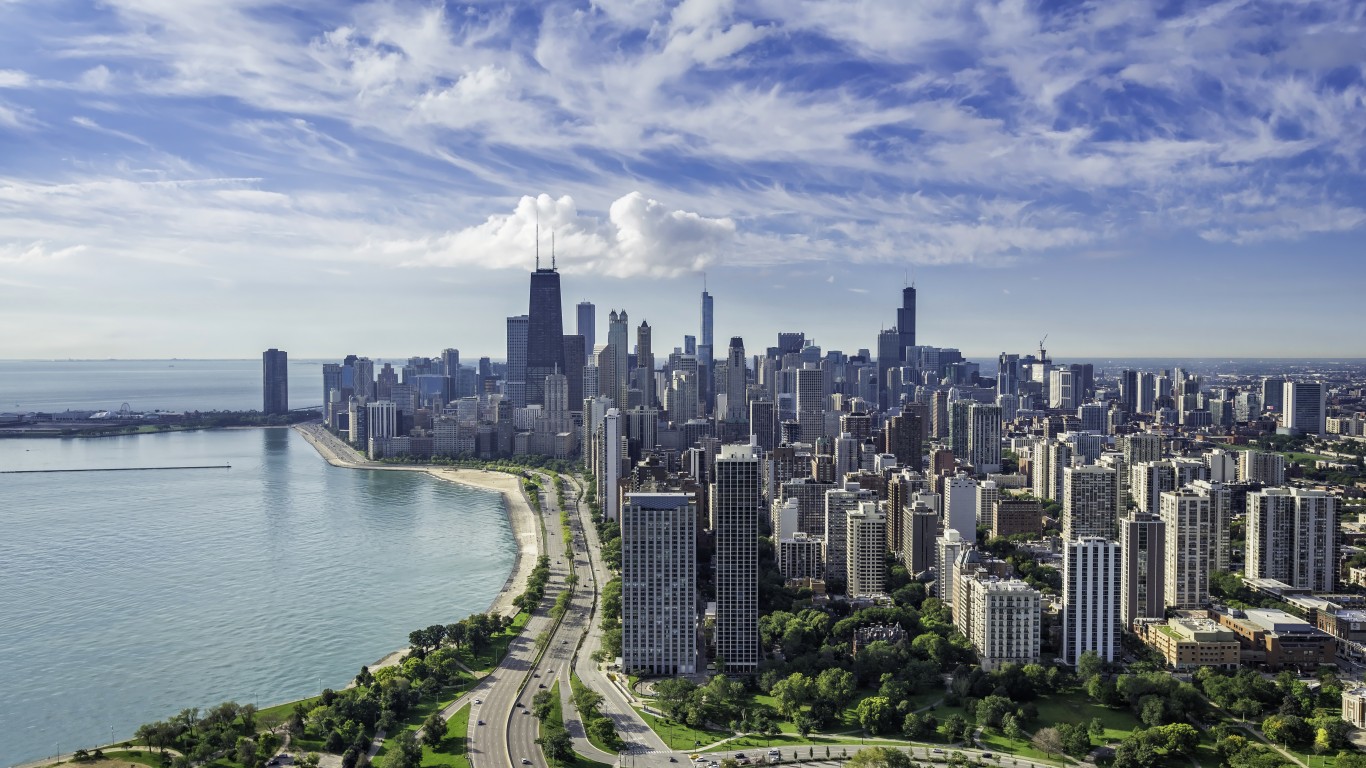
15. Illinois
> Workforce in high-risk industries: 18.8% of total (17th highest)
> Unemployment claims since mid-March: 1,097,354 (17.0% of workforce — 11th lowest)
> COVID cases as of June 1, 2020: 121,234 (952 per 100,000 people — 7th highest)
> COVID deaths as of June 1, 2020: 5,412 (42 per 100,000 people — 9th highest)
> April unemployment rate: 16.4% (7th highest)
The unemployment rate stands at 16.4% in Illinois, higher than in all but half a dozen states. The high unemployment will mean lower revenue for the state government (such as in the form of income taxes), and Illinois is not well equipped to handle a revenue shortfall. The state has only $4 million saved in a rainy fund — not enough to cover even one-tenth of one percent of its annual budget. In fiscal 2021, Illinois is projected to face a 15.8% budget shortfall.
Illinois has been hit particularly hard by the virus itself. There have been 952 confirmed cases for every 100,000 people through June 1, more than in all but a handful of other states.
[in-text-ad]

14. Washington
> Workforce in high-risk industries: 15.0% of total (5th lowest)
> Unemployment claims since mid-March: 1,263,521 (32.6% of workforce — 4th highest)
> COVID cases as of June 1, 2020: 21,702 (288 per 100,000 people — 21st lowest)
> COVID deaths as of June 1, 2020: 1,118 (15 per 100,000 people — 22nd highest)
> April unemployment rate: 15.4% (11th highest)
In Washington state, a staggering 32.6% of the workforce has filed for unemployment since March 15, the fourth highest share among states. Washington was one of the first states to be hit hard by COVID-19, and on March 23 became one of the first states to issue a stay-at-home order. Some parts of the state have begun to reopen, but the Seattle region remains locked down.

13. Mississippi
> Workforce in high-risk industries: 19.1% of total (16th highest)
> Unemployment claims since mid-March: 292,836 (23.1% of workforce — 20th highest)
> COVID cases as of June 1, 2020: 15,752 (527 per 100,000 people — 16th highest)
> COVID deaths as of June 1, 2020: 739 (25 per 100,000 people — 14th highest)
> April unemployment rate: 15.4% (11th highest)
As of June 1, Mississippi ranked 16th overall in confirmed coronavirus cases per capita, at 527 per 100,000 residents. However, in recent weeks, the rolling 7-day average of daily new cases has increased in the state, from less than 250 in mid-May to 328 as of June 1. Prior to the pandemic, Mississippi had an above-average share of employment in industries highly at-risk of a slowdown in the wake of the pandemic, including leisure and hospitality and transportation and warehousing. Since mid-March, roughly 23% of the state’s labor force has filed for unemployment.

12. Pennsylvania
> Workforce in high-risk industries: 16.7% of total (20th lowest)
> Unemployment claims since mid-March: 1,920,670 (29.8% of workforce — 10th highest)
> COVID cases as of June 1, 2020: 72,282 (564 per 100,000 people — 14th highest)
> COVID deaths as of June 1, 2020: 5,567 (43 per 100,000 people — 8th highest)
> April unemployment rate: 15.1% (16th highest)
Pennsylvania is one of the states hit worst by the coronavirus pandemic in terms of both the spread of the virus and economic fallout. As of June 1, there were 564 confirmed COVID-19 cases per 100,000 residents in Pennsylvania, the 14th highest infection rate of any state. There have been 44 deaths per 100,000, the eighth highest death rate.
From April 2019 to April 2020, Pennsylvania saw an 11.0 percentage-point increase in the unemployment rate, the 15th largest increase of any state. The unemployment rate now stands at 15.1%, the 16th highest such figure nationwide. Since March 15, some 29.8% of the state’s labor force — 1.9 million Pennyslvanians — have applied for unemployment, the 10th largest share of any state.
[in-text-ad-2]
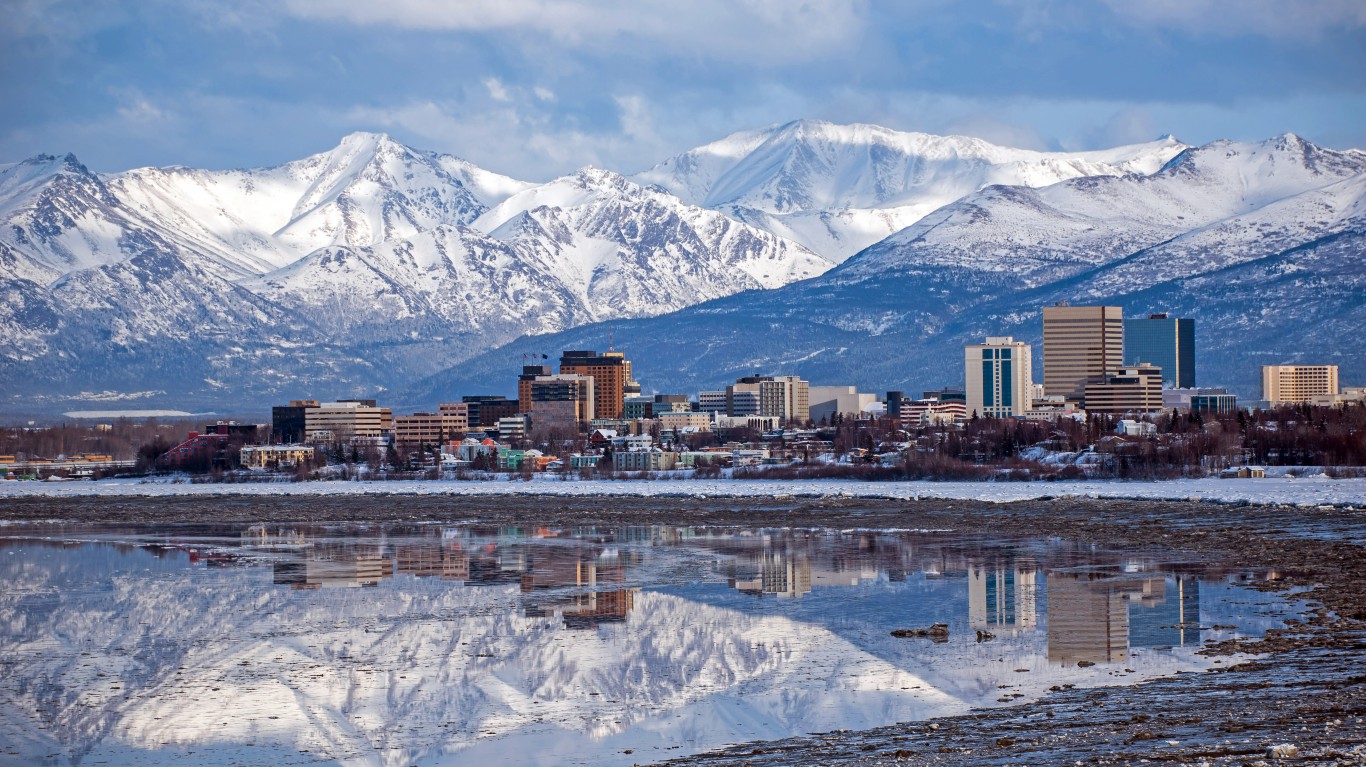
11. Alaska
> Workforce in high-risk industries: 21.8% of total (4th highest)
> Unemployment claims since mid-March: 104,361 (30.2% of workforce — 9th highest)
> COVID cases as of June 1, 2020: 467 (63 per 100,000 people — 3rd lowest)
> COVID deaths as of June 1, 2020: 10 (1 per 100,000 people — 2nd lowest)
> April unemployment rate: 12.9% (25th highest)
While Alaska has been relatively isolated from the physical spread of coronavirus — with just 63 confirmed COVID-19 cases per 100,000 as of June 1 — the state is particularly vulnerable to the economic consequences of the pandemic. The Alaskan economy is heavily dependent on the oil and gas sector, which has shrunk in recent months alongside the global downturn in economic activity. An estimated 21.8% of Alaskan workers are employed in industries classified as high-risk due to the coronavirus, the fourth largest share of any state.
According to Moody’s, Alaska will face a 66.8% decline in state revenue through fiscal 2021, the largest decrease of any state. But while Alaska will face a large fiscal shock, the state’s rainy day fund — equivalent to 85.3% of expenditures as of fiscal 2019, the second largest in the nation — will likely prevent the need for any budget cuts in 2021.

10. Massachusetts
> Workforce in high-risk industries: 15.0% of total (6th lowest)
> Unemployment claims since mid-March: 902,261 (23.7% of workforce — 16th highest)
> COVID cases as of June 1, 2020: 100,805 (1,460 per 100,000 people — 3rd highest)
> COVID deaths as of June 1, 2020: 7,035 (102 per 100,000 people — 4th highest)
> April unemployment rate: 15.1% (16th highest)
While Massachusetts is relatively insulated from the economic consequences of the pandemic — just 15.0% of workers are employed in high-risk industries, the sixth smallest share of any state — the severity of the COVID-19 outbreak in Massachusetts may curb economic activity in the state for a longer period than in most of the nation. As of June 1, there were 1,460 confirmed COVID-19 cases per 100,000 Massachusetts residents, the third highest infection rate of any state. Massachusetts has some of the strictest coronavirus restrictions in place, and consumer confidence is lower than in all but two other states, according to analysis from Morning Consult.
The unemployment rate in Massachusetts rose 12.1 percentage points from April 2019 to April 2020, the 10th largest increase of any state. The state’s unemployment rate now stands at 15.1%, more than the 14.7% national figure.
[in-text-ad]

9. New York
> Workforce in high-risk industries: 15.1% of total (7th lowest)
> Unemployment claims since mid-March: 2,420,559 (25.4% of workforce — 13th highest)
> COVID cases as of June 1, 2020: 371,711 (1,902 per 100,000 people — the highest)
> COVID deaths as of June 1, 2020: 23,959 (123 per 100,000 people — 2nd highest)
> April unemployment rate: 14.5% (19th highest)
While workers in nearly all industries have been affected by the economic fallout from the COVID-19 pandemic, in some industries, workers have been hurt more than others. In New York, prior to the pandemic outbreak, a nation-leading 56% of employment was in industries deemed by Moody’s low risk to the effects of the pandemic, including financial activities, information, and health care.
However, New York has also been the hardest hit state by COVID-19, with 1,902 confirmed cases per 100,000 people, the highest of any state and considerably higher than the national figure of 547 cases per 100,000. Just over 25% of the state’s labor force has filed for unemployment since mid-march, one of the higher figures of any state.

8. Michigan
> Workforce in high-risk industries: 16.4% of total (17th lowest)
> Unemployment claims since mid-March: 1,496,219 (30.3% of workforce — 7th highest)
> COVID cases as of June 1, 2020: 57,532 (576 per 100,000 people — 12th highest)
> COVID deaths as of June 1, 2020: 5,516 (55 per 100,000 people — 7th highest)
> April unemployment rate: 22.7% (2nd highest)
From April 2019 to April 2020, Michigan’s unemployment rate rose by 18.4 percentage points, the third largest increase of any state. The state’s unemployment rate now stands at 22.7%, the second highest in the nation. Since March 15, 1.5 million state residents have applied for unemployment benefits, equivalent to 30.3% of the Michigan labor force — the seventh largest share of any state.
According to Moody’s, Michigan will face a 27.0% decline in state revenue through fiscal 2021, the ninth largest decrease of any state. And while Michigan has one of the largest rainy day funds of any state, it is not enough to protect the state against the financial shock. Moody’s projects Michigan will face a 15.9% budget shortfall in 2021, the eighth largest shortfall nationwide.
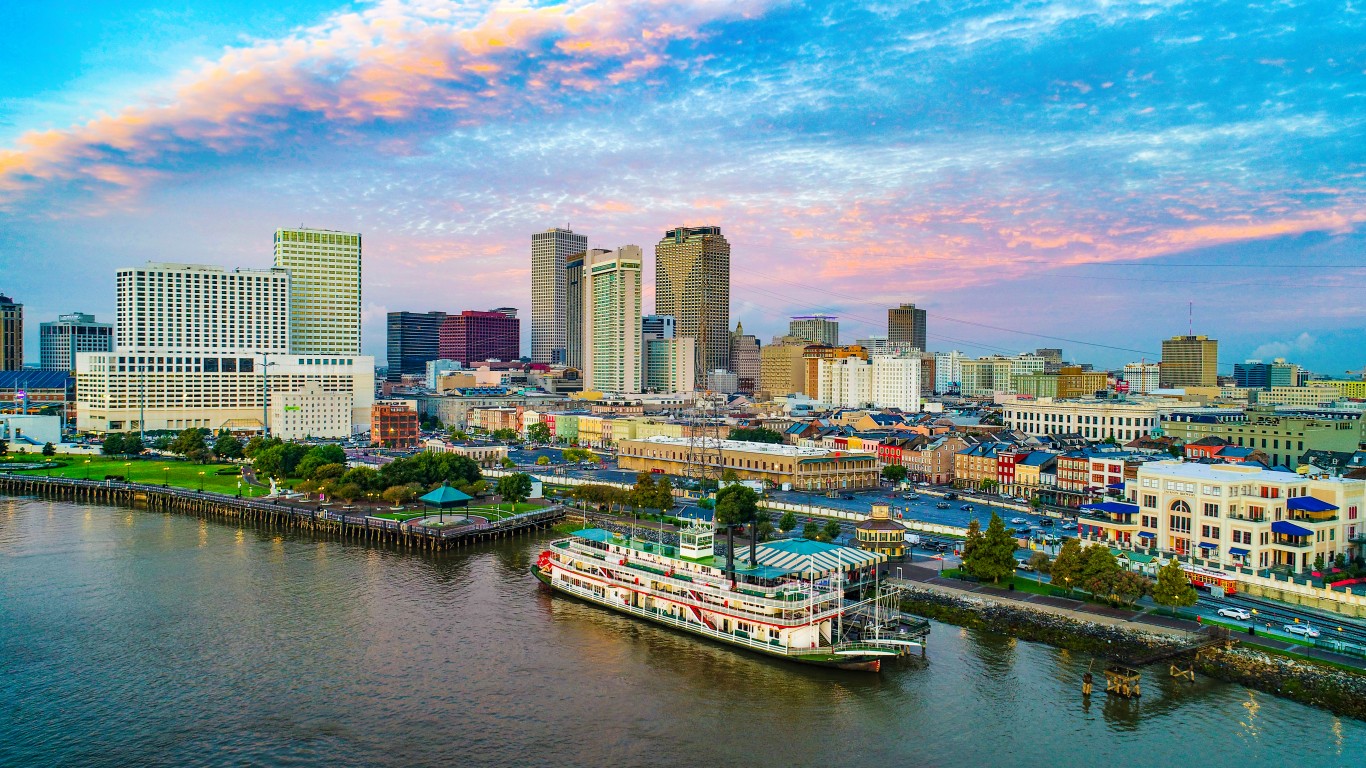
7. Louisiana
> Workforce in high-risk industries: 19.5% of total (12th highest)
> Unemployment claims since mid-March: 651,756 (31.3% of workforce — 5th highest)
> COVID cases as of June 1, 2020: 40,341 (866 per 100,000 people — 9th highest)
> COVID deaths as of June 1, 2020: 2,690 (58 per 100,000 people — 6th highest)
> April unemployment rate: 14.5% (19th highest)
Nearly one in every five workers in Louisiana are employed in industries at high risk of slowdown in the wake of the pandemic. Partially as a result, the state’s unemployment rate stands at 14.5% — higher than in a majority of other states. That figure will likely only keep climbing as more than 651,000 Louisiana residents have filed for unemployment since mid-March, or over 31% of the state’s total workforce — the fifth highest share among states.
[in-text-ad-2]
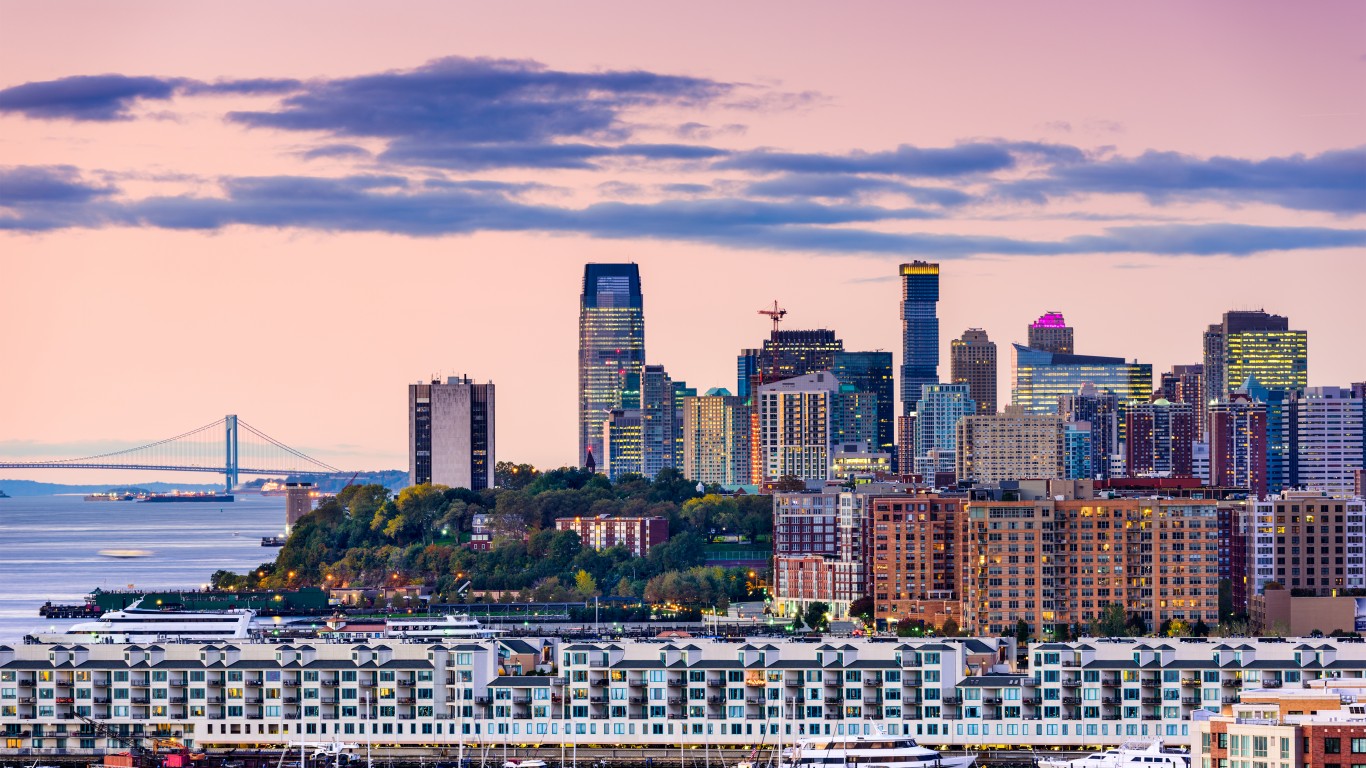
6. New Jersey
> Workforce in high-risk industries: 17.4% of total (24th highest)
> Unemployment claims since mid-March: 1,123,237 (25.2% of workforce — 14th highest)
> COVID cases as of June 1, 2020: 160,918 (1,806 per 100,000 people — 2nd highest)
> COVID deaths as of June 1, 2020: 11,721 (132 per 100,000 people — the highest)
> April unemployment rate: 15.3% (14th highest)
New Jersey is home to one of the worst COVID-19 outbreaks in the world. As of June 1, there were 1,806 confirmed COVID-19 cases per 100,000 state residents, the second highest infection rate of any state. There have been 132 deaths per 100,000, the highest death rate.
The delay in economic activity that will result from the severity of the pandemic in New Jersey is likely to result in a recession that the state is hardly prepared for. Moody’s projects the state will suffer a 27.2% decline in revenue through fiscal 2021, the eighth largest contraction of any state. And with a financial reserve equivalent to just 1.1% of annual expenditure — the sixth smallest rainy day fund of any state — New Jersey is projected to face a 26.2% budget shortfall in fiscal 2021, the second largest nationwide.

5. Kentucky
> Workforce in high-risk industries: 19.4% of total (13th highest)
> Unemployment claims since mid-March: 843,661 (41.0% of workforce — 2nd highest)
> COVID cases as of June 1, 2020: 10,046 (225 per 100,000 people — 12th lowest)
> COVID deaths as of June 1, 2020: 439 (10 per 100,000 people — 20th lowest)
> April unemployment rate: 15.4% (11th highest)
Prior to the crisis, Kentucky had one of the highest shares of state employment in industries most vulnerable to the economic effects of the pandemic, including transportation and warehousing. The state has the second highest share of any state of employment in the sector. The state’s roughly 840,000 new unemployment claims since mid-March constitute 41% of the state’s total workforce, the second highest share of any U.S. state.
[in-text-ad]
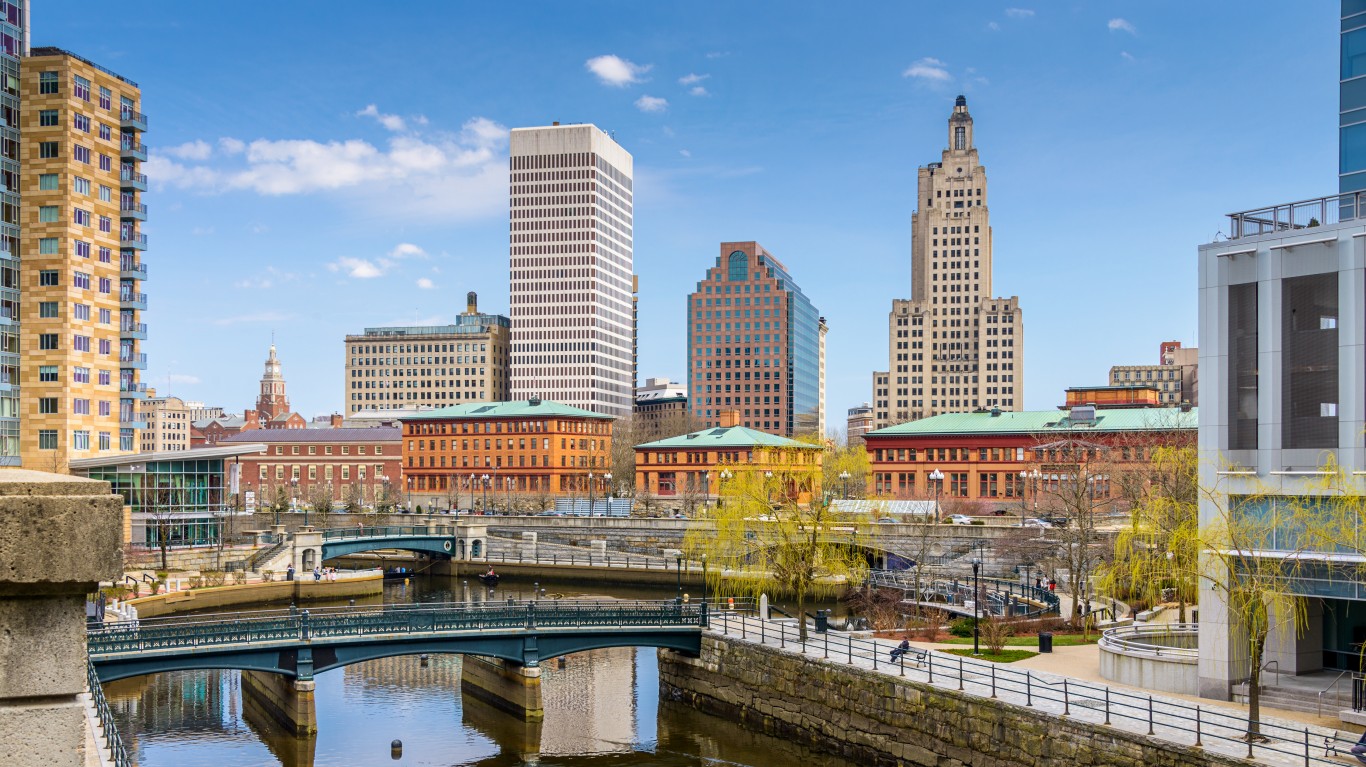
4. Rhode Island
> Workforce in high-risk industries: 17.1% of total (25th highest)
> Unemployment claims since mid-March: 167,197 (30.3% of workforce — 8th highest)
> COVID cases as of June 1, 2020: 14,991 (1,418 per 100,000 people — 4th highest)
> COVID deaths as of June 1, 2020: 720 (68 per 100,000 people — 5th highest)
> April unemployment rate: 17.0% (4th highest)
Like many other densely-populated states in the Northeast, Rhode Island has been hit especially hard by COVID-19, with over 1,400 confirmed cases per 100,000 residents as of June 1, compared to the national figure of 547 per 100,000. The state’s official unemployment rate as of April was 17%, the fourth highest of any state. That figure is likely to rise a great deal in May, as total unemployment filings in the state since mid-March exceeded 30% of the state’s labor force.
The state’s labor department issued a statement on April 29 saying the pandemic will result in $1.1 billion in lost wages for state workers through the second quarter of 2020.

3. Georgia
> Workforce in high-risk industries: 19.7% of total (9th highest)
> Unemployment claims since mid-March: 2,179,120 (42.7% of workforce — the highest)
> COVID cases as of June 1, 2020: 47,916 (455 per 100,000 people — 19th highest)
> COVID deaths as of June 1, 2020: 2,089 (20 per 100,000 people — 15th highest)
> April unemployment rate: 11.9% (19th lowest)
Georgia’s economy is heavily dependent on a number of industries vulnerable to the effects of a COVID-19-driven recession. Some 19.7% of the workforce is employed in industries classified by Moody’s as high-risk to the economic effects of the pandemic, the ninth largest share of any state. And while the physical spread of COVID-19 in Georgia has been mild compared to the nation as a whole, the state has had one of the worst economic fallouts.
Since March 15, 2.2 million Georgia residents have filed for unemployment benefits. This amounts to 42.7% of the labor force, the largest share nationwide. According to the Georgia Department of Labor, some of the hardest-hit industries in the state include trade, educational services, information, administration, waste management, transportation, warehousing, and construction.

2. Hawaii
> Workforce in high-risk industries: 27.1% of total (2nd highest)
> Unemployment claims since mid-March: 241,260 (36.3% of workforce — 3rd highest)
> COVID cases as of June 1, 2020: 652 (46 per 100,000 people — the lowest)
> COVID deaths as of June 1, 2020: 17 (1 per 100,000 people — the lowest)
> April unemployment rate: 22.3% (3rd highest)
Hawaii is more dependent on tourism than nearly any other state — and few industries have suffered more in the wake of the pandemic than tourism. The unemployment rate in Hawaii now stands at a staggering 22.3% — higher than in all but three other states. That rate will only likely climb higher, as, since mid-March, nearly a quarter million Hawaiians have filed for unemployment, equal to more than 36% of the workforce. Hawaii is one of only three states where over a third of the workforce have filed for unemployment in the last few months.
[in-text-ad-2]

1. Nevada
> Workforce in high-risk industries: 33.5% of total (the highest)
> Unemployment claims since mid-March: 471,740 (30.8% of workforce — 6th highest)
> COVID cases as of June 1, 2020: 8,000 (264 per 100,000 people — 16th lowest)
> COVID deaths as of June 1, 2020: 387 (13 per 100,000 people — 25th highest)
> April unemployment rate: 28.2% (the highest)
Prior to the pandemic, over one-third of Nevada’s employment was in industries that are at the highest levels of risk from the economic effects of the pandemic. This is about double the national concentration of employment in these industries. The effects of that concentration have been felt statewide as Nevada’s unemployment rate in April reached 28.2%, by far the highest unemployment rate of any state.
On March 17, Gov. Steve Sisolak ordered all casinos in the state to cease operations. In April, the state’s casino revenue fell to just $3 million, more than a 99% decline compared to April 2019. Even as state casinos are slated to open it later in June, it could take months before gaming revenue returns to pre-crisis levels.
Methodology:
To determine the states most likely to be hurt economically by COVID-19, 24/7 Wall St. created a weighted index of four measures. The first measure, which comprises 30% of the index, is the share of total employment in industries deemed to be at high risk of slowdown due to the coronavirus outbreak. The second measure, which comprises 20% of the index, is the number of diagnosed cases per capita as of June 1, 2020. The third measure, which comprises 30% of the index, is the cumulative number of new unemployment claims made since the week ending March 21 as a share of the state labor force as of February 2020, from the U.S. Department of Labor and the U.S. Bureau of Labor Statistics. The fourth measure, which comprises 20% of the index, is the April unemployment rate, also from the BLS.
The identification of high-risk industries comes from the March 2020 paper “COVID-19: A Fiscal Stimulus Plan” published by Moody’s Analytics, an economics research firm.
Data on COVID-19 cases and deaths by state came from various state and local health departments and are current as of June 1, 2020. COVID-19 cases and death toll were adjusted for population using five-year estimates from the U.S. Census Bureau’s 2018 American Community Survey. Population density was calculated using 2010 land area estimates from the Census Bureau and one-year population estimates from the 2018 ACS.
Supplemental data on rainy day fund balance at the end of fiscal 2019 as a percentage of expenditure, projected state revenue loss through fiscal 2021 relative to fiscal 2019 general fund revenues, and the projected budget shortfall in fiscal 2021 that would result for each state came from the April 2020 paper “Stress-Testing States: COVID-19” published by Moody’s. Estimated budget shortfalls refer to the state revenue loss through 2021 that would not be covered by reserves during a severe recession, and are based on Moody’s analysis.
Thank you for reading! Have some feedback for us?
Contact the 24/7 Wall St. editorial team.